
Maria Pappas
Cook County Treasurer
🖥
Publication of the Cook County Treasurer’s Research Department
All Rights Reserved
studies and helpful information
for property owners
www.cookcounty treasurer.com
Oce of Cook County Treasurer Maria Pappas
April 2024 Update
(Original: August 2023 )
How the Illinois
Property Tax
System Works
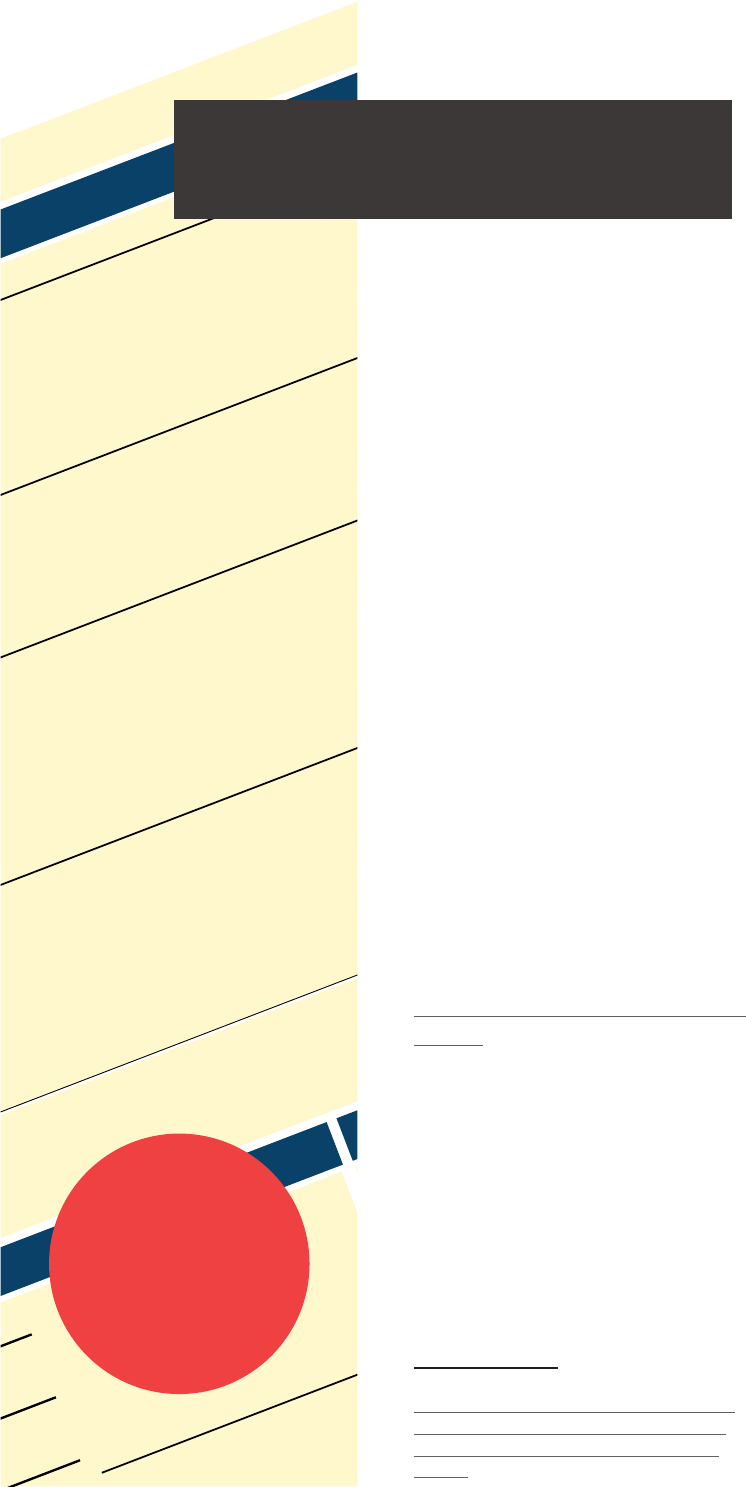
IF PAYING LATE,
PLEASE PAY
07/02/2023 - 08/01/2023
$0.00
08/02/2023 - 09/01/2023
$0.00
09/02/2023 - 10/01/2023
$0.00
LATE INTEREST IS 1.5% PER
MONTH, BY STATE LAW
TAXING DISTRICT BREAKDOWN
Taxing Districts
2021 Tax
2021 Rate
2021 %
Pension
2020 Tax
MISCELLANEOUS TAXES
Des Plaines Valley Mosq Abate Dist Lyons
6.17
0.014
0.10%
5.68
Metro Water Reclamation Dist of Chicago
168.42
0.382
2.73%
18.51
178.90
Summit Public Library District
193.55
0.439
3.14%
4.40
252.74
Summit Park District
241.17
0.547
3.91%
18.51
231.91
Miscellaneous Taxes Total
609.31
1.382
9.88%
669.23
SCHOOL TAXES
Moraine Valley College 524 Palos Hills
173.71
0.394
2.82%
166.12
Argo Community HS District 217 (Summit)
1,625.56
3.687
26.37%
51.14
1,526.83
Summit School District 104
2,436.36
5.526
39.52%
132.70
2,616.35
School Taxes Total
4,235.63
9.607
68.71%
4,309.30
MUNICIPALITY/TOWNSHIP TAXES
Village of Summit
1,012.72
2.297
16.43%
345.65
1,016.15
Lyons Mental Health
38.36
0.087
0.62%
37.86
Road & Bridge Lyons
17.19
0.039
0.28%
17.04
General Assistance Lyons
2.20
0.005
0.04%
1.42
Town of Lyons
18.96
0.043
0.31%
18.93
Municipality/Township Taxes Total
1,089.43
2.471
17.68%
1,091.40
COOK COUNTY TAXES
Cook County Forest Preserve District
25.57
0.058
0.41%
0.88
27.45
Consolidated Elections
8.38
0.019
0.14%
0.00
County of Cook
107.14
0.243
1.73%
38.79
128.76
Cook County Public Safety
57.76
0.131
0.94%
62.47
Cook County Health Facilities
31.74
0.072
0.51%
23.19
Cook County Taxes Total
230.59
0.523
3.73%
241.87
TAX CALCULATOR
IMPORTANT MESSAGES
2020 Assessed Value
14,683
2021 Property Value
146,830
2021 Assessment Level
X 10%
2021 Assessed Value
14,683
2021 State Equalizer
X 3.0027
2021 Equalized Assessed Value (EAV)
44,089
2021 Local Tax Rate
X 13.983%
2021 Total Tax Before Exemptions
6,164.96
2021 Total Tax Before Exemptions
6,164.96
Homeowner's Exemption
.00
Senior Citizen Exemption
.00
Senior Freeze Exemption
.00
2021 Total Tax After Exemptions
6,164.96
First Installment
3,471.49
Second Installment +
2,693.47
Total 2021 Tax (Payable in 2022)
6,164.96
PROPERTY LOCATION
5519 S 72ND CT
SUMMIT IL 60501 2205
(Do not pay these totals)
6,164.96
13.983
100.00%
6,311.80
2021 Second Installment Property Tax Bill - Cook County Electronic Bill
Property Index Number (PIN)
Volume
Code
Tax Year
(Payable In)
Township
Classification
18-13-206-015-0000
080
21038
2022
(2023)
LYONS
2-03
$0.00
By 07/01/2023
*** Please see 2021 Second Installment Payment Coupon next page ***
MAILING ADDRESS
FRANCISCO J URBINA
5155 S MELVINA AVE
CHICAGO IL 606381430
TOTAL PAYMENT DUE
The Treasurer’s
Oce sends more
than 3.2 Million
Tax Bills every
single year.
Property taxes have served as a way to fund government
in the United States since the founding of the country
— at a time when property ownership typically was syn-
onymous with wealth, making it a mostly progressive tax
in the 18th and 19th centuries.
Introduction
The federal government and
the vast majority of state
governments have stopped
using that tax to fund
government, in part because
property ownership and wealth
are no longer so closely linked,
making it a regressive tax in
many instances.
Nevertheless, property taxes
continue to be a major source of
revenue for local governments.
In 40 U.S. states, the biggest
single source of income for local
governments is the property tax,
according to the Pew Research
Center
1
.
It remains the case despite a
growing body of studies that
question whether the overall
property tax burden can be
spread equitably, whether the
revenue it generates can be dis-
tributed fairly and whether the
1 (The Pew Charitable Trusts, 2021)
https://www.pewtrusts.org/en/research-
and-analysis/data-visualizations/2021/
how-local-governments-raise-their-tax-
dollars
enforcement of tax payments
through sales of delinquent
taxes disproportionately affects
people of color.
In Illinois, those questions
have dominated the debate
over property taxes in recent
decades, leading to limits
on property tax increases, a
revamping of the Cook County
property tax assessment
system, reforms to the state
property tax code and changes
to the way the state distributes
public-school funding to make
educational opportunities more
equitable between wealthier and
poorer communities.

Photo Credits
Andrew Jameson, left
Rachel Bires, right
Contents
Introduction ...........................1
Pension liabilities .......................5
So Many Government Agencies.. .............6
The Cook County Property Tax Process ........9
Appendix .............................27
Offices Involved in Property Taxation ........29
Additional Sources ......................30
References ...........................31
Glossary .............................33
2

How the Illinois Property Tax System Works
Illinois nevertheless continues to
rely heavily on property taxes to
fund local government, particu-
larly for kindergarten through
12th grade public education.
Historically, more than half of
public-school funding in the
state has come from property
tax-derived revenue, according
to the Illinois State Board of
Education
2,3
(Figure 1).
In Illinois, 39% of all local gov-
ernment revenue comes from
property taxes, according to
the Lincoln Institute for Land
Policy
4
. That compares with
an average of 30% across the
nation.
Although many other states rely
more heavily, in percentage of
revenue, on property taxes to
fund local government, Illinois
still has the nation’s second-
highest effective residential
property tax rates
5
— dened as
the percentage of a property’s
2 (Illinois State Board of Education, 2021
Annual Report) https://www.isbe.net/
Documents/2021-Annual-Report.pdf
3 In the 2020-2021 school year, when
school coffers, the percentage of public
education derived from property taxes
dropped to 43.5%, but that number will rise
again in coming years once all pandemic
funds are spent.
4 (Lincoln Institute of Land Policy,
“State-by-State Property Tax at a
Glance,” 2023) https://www.lin-
colninst.edu/research-data/data-
state-state-property-tax-glance
5 (ibid) https://www.lincolninst.
edu/research-data/data-toolkits/
state-state-property-tax-glance
value that is paid in taxes each
year, according to multiple
studies. Only New Jersey has
a higher effective property tax
rate. (See Figure 2)
Looked at another way, the
median residential property tax
bill in Illinois between 2015 and
2019 was $4,529, compared to
an average of $2,551 across the
nation, according to the Lincoln
Institute. That median Illinois
tax bill is the sixth highest in the
country.
There are many reasons that
property taxes are higher in
Illinois than other states that
rely more heavily, in percent-
age terms, on that tax for local
revenue. Among them: the
heavy reliance on the tax for
school funding, outsized costs
associated with restoring nan-
cial health to the state’s under-
funded government worker and
teacher pension systems, and
the high number of local govern-
ments in the state.
Illinois state govern ment pays
about 24% of all kindergarten
through 12th grade public
education costs, after pay-
ments for teacher pensions are
factored out, according to the
Illinois State Board of Education.
That’s the lowest funding level
among all 50 states, according
to the Center for Budget and Tax
Accountability.
6
6 (Illinois Report Card, 2022-2023 ), 2022)
https://www.illinoisreportcard.com/State.
aspx?source=environment&source2=reven
uepercentages
Federal Taxes
24.7%
State Taxes
31.9%
Local Property Taxes
43.5%
0%
10%
20%
30%
40%
50%
60%
70%
2000-
2001
2002-
2003
2004-
2005
2006-
2007
2008-
2009
2010-
2011
2012-
2013
2014-
2015
2016-
2017
2018-
2019
2020-
2021
% of Total Education Funding
2000-2021
See Footnote 3
Figure 1. Share of education funding by jurisdiction (Source: Illinois State Board of Education
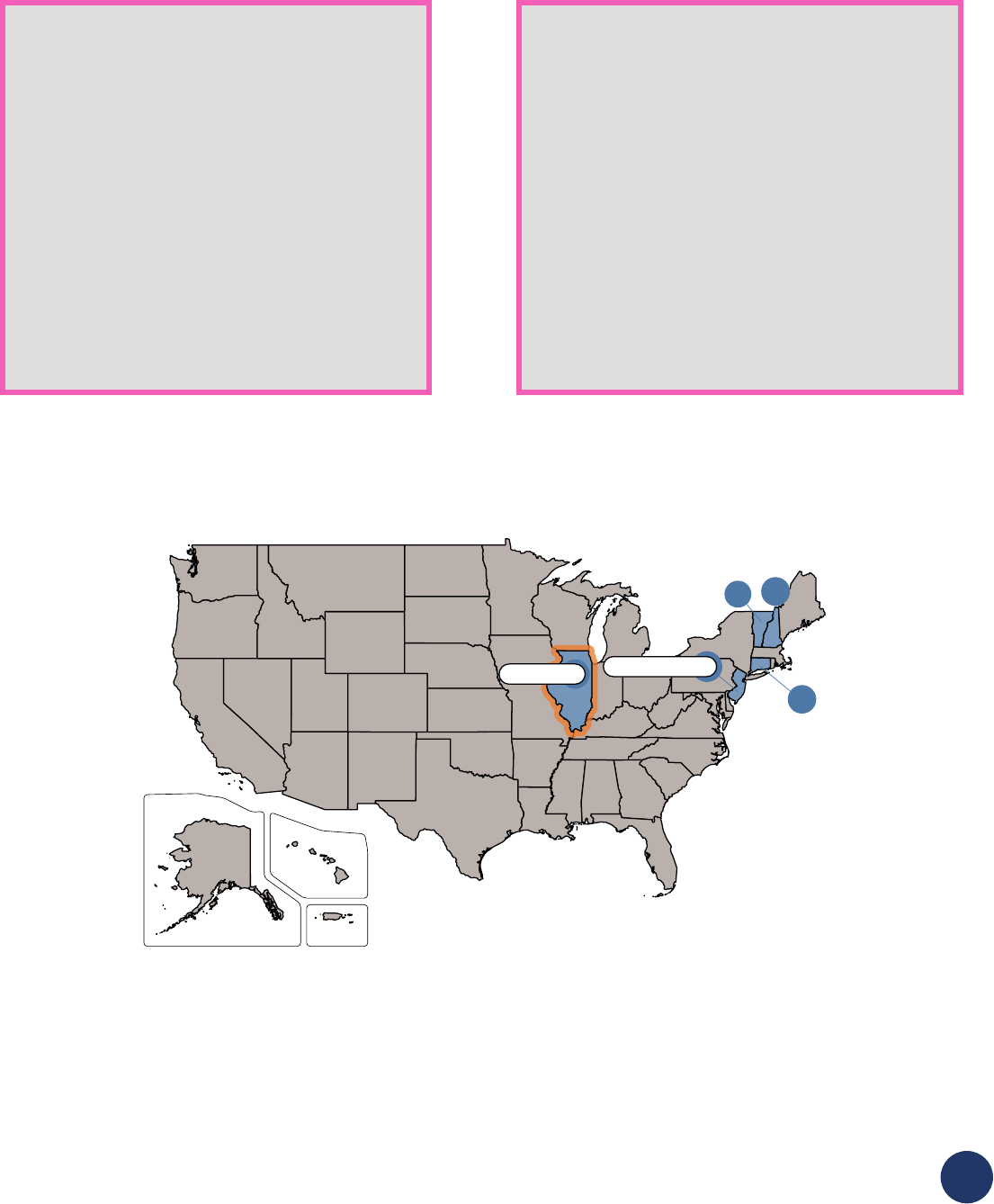
2.1%
2.1%
2.5
1.9%
Illinois 2.2%
New Jersey 2.5%
$2,551
Median Residential
Property
Tax Bill in the U.S.
$4,529
Median Residential
Property Tax Bill in
Illinois
Figure 2. The top ve states in the US in terms of effective property tax (Source: Lincoln Institute of Land
Policy)
4

How the Illinois Property Tax System Works
The 15 local government agencies with the highest levels
of unfunded pension liabilities in Cook County
Agency Name Total Liability Unfunded Liability
Funded
Ratio*
City of Chicago $73,965,305,000 $35,436,606,937 21.03%
Chicago Public
Schools
$30,130,285,000 $16,011,799,929 38.93%
County of Cook $19,531,125,441 $10,837,262,891 52.71%
Metro Water
Reclamation Dist.
$4,170,650,000 $1,020,180,000 66.04%
Chicago Park District $2,931,436,000 $1,691,529,000 16.91%
Village of Rosemont $785,915,187 $28,771,294 54.15%
Town of Cicero $593,244,407 $203,692,117 29.57%
Village of
Schaumburg
$581,210,504 $219,229,038 63.47%
City of Evanston $569,373,515 $185,786,857 73.59%
Cook County Forest
Preserve District
$548,552,253 $334,111,011 38.07%
City of Elgin $523,328,022 $194,043,835 73.92%
Village of Oak Lawn $505,889,070 $203,318,980 50.21%
School District U-46
(Elgin)
$431,703,576 $50,818,670 82.36%
City of Berwyn $410,163,141 $41,772,166 83.36%
Village of Oak Park $375,012,286 $139,192,803 67.35%
*Unfunded liabilities in this chart are calculated on an accrual basis. Individual
pension funds often calculate these numbers on an actuarial basis.
In addition, many municipalities
across Illinois have some of
the highest unfunded pension
liabilities in the U.S., which can
result in steep tax increases as
municipalities and counties take
steps to comply with a state
law that mandates those local
pension funds achieve 90%
funding
7
in the coming decades
(Figure 3).
decision:’ Niles Village Board approves
88% increase in property-tax levy,
2021) https://www.chicagotribune.
com/suburbs/niles/ct-nhs-tax-levy-tl-
1223-20211216-rv5odlvwp5aqrcdlaudbllx-
tvi-story.html
Pension Liabilities
Figure 3. Top Sources of Pension and Post-Employment Liabilities in Cook County, IL, (Source: The Pappas
Studies, Debt Report)
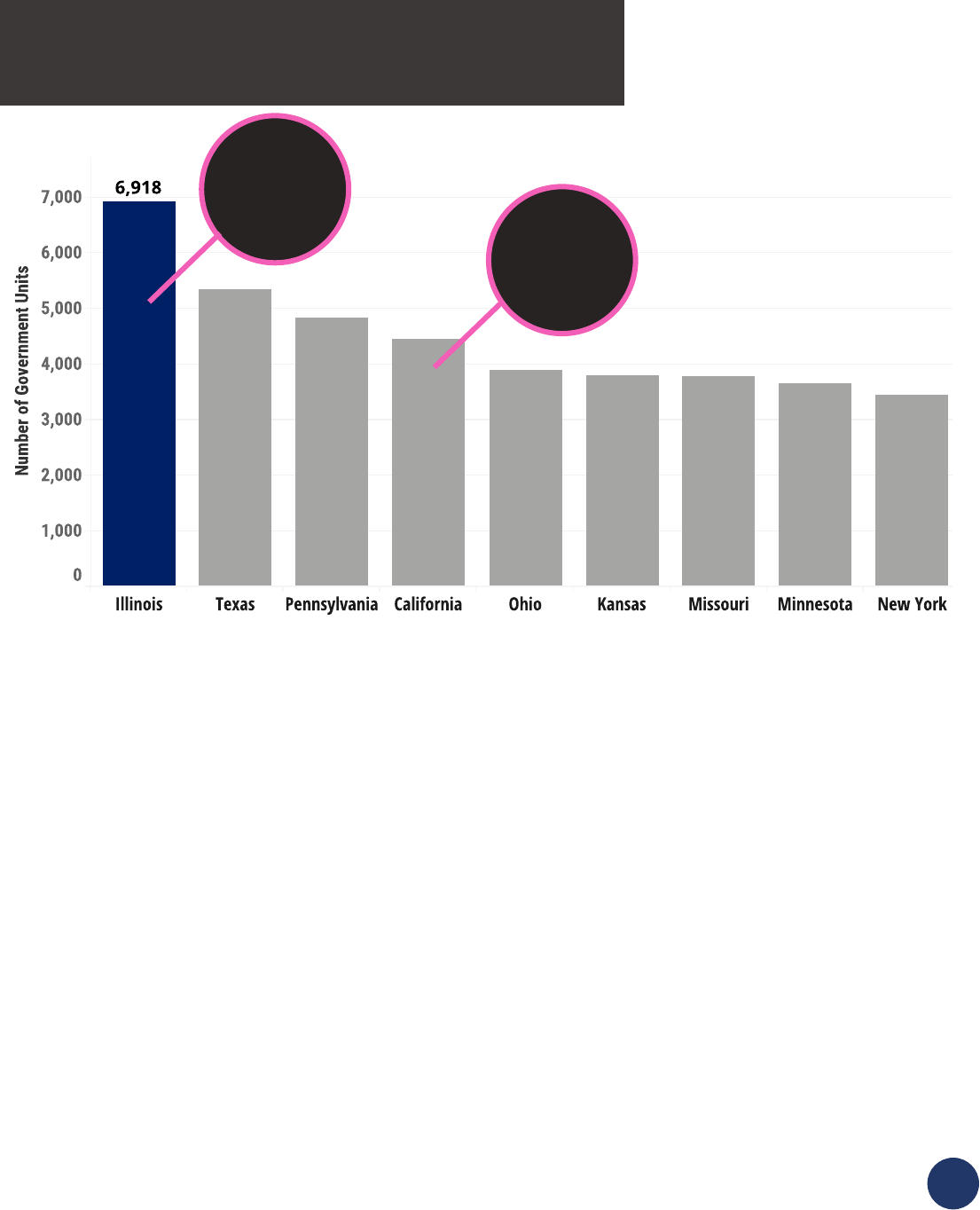
Another factor driving up the overall cost of
local government in Illinois is the extraordinarily
high number of local governments in the state.
Surveys from both the U.S. Census Bureau
and the Civic Federation government budget
watchdog group found that Illinois has the most
local governments of any state in the union. Each
government has its own bureaucracy that adds
costs borne by taxpayers (Figure 4).
Local governments across the nation tend to rely
heavily on property taxes because the amount
collected is generally stable. When the economy
falters, the other two major local government
sources of revenue — sales taxes and local
income taxes (Illinois does not have the latter) —
tend to decline.
Property taxes in many states don’t decline with
a downward turn in the economy, because of the
way they are determined. In those states, local
government property tax levies — the amount
governments seek to collect in a given year — are
established after budgets are drawn up, without
regard to ups and downs in the values of the
properties on which the taxes are paid. Sales
and income taxes, in contrast, are xed at certain
percentages, so the receipts from those two taxes
fluctuate based on consumers’ nancial health.
Figure 4. Top states by number of
sub-units of governments (Source:
U.S. Census)
So Many Government Agencies..
1 FOR
EVERY
1,800
PEOPLE
1 FOR
EVERY
8,800
PEOPLE
6

How the Illinois Property Tax System Works
No two states’ property tax systems are the
same, and in several, there are variations from
one locale to another. But generally, there are two
ways property taxes are set in the U.S.
2
)
In other states, including Texas, properties are rst assessed and then the rate is set, deter-
mining the amount of taxes to be collected. That method also allows local governments to
increase their rates when the total value of all property declines — unless the state enacts
strict rate limits.
*
Assessments Decrease
$100,000,000 to
$87,500,000
Tax Rate Increases
1% to 1.143%
Total Tax Amount
$1 million
* Many states, including Arizona and California, in recent decades have placed stricter limits on
tax rates through statutory and constitutional amendments, according to the Lincoln Institute
8
.
In those states, property tax bills can decrease when property values decline, but so do the
revenues at a time when governments are asked to do more.
Assessment Decreases
$100,000,000 to
$87,500,000
Tax Rate is Limited
1%
Total Tax Amount
$875,000
8 (Lincoln Institute of Land Policy, 2022)
state-state-property-tax-glance
1
)
In many states, like Illinois, New York and New Jersey, the levy — the overall amount of property
taxes sought by local taxing agencies — is set rst, followed by the tax rate. If the total value
of local properties declines, the tax rate is set higher to ensure the full levy is collected from
property owners.
Assessments Decrease
$100,000,000 to
$87,500,000
Total Tax Amount Set
$1 million
Tax Rate Increases
1% to 1.143%
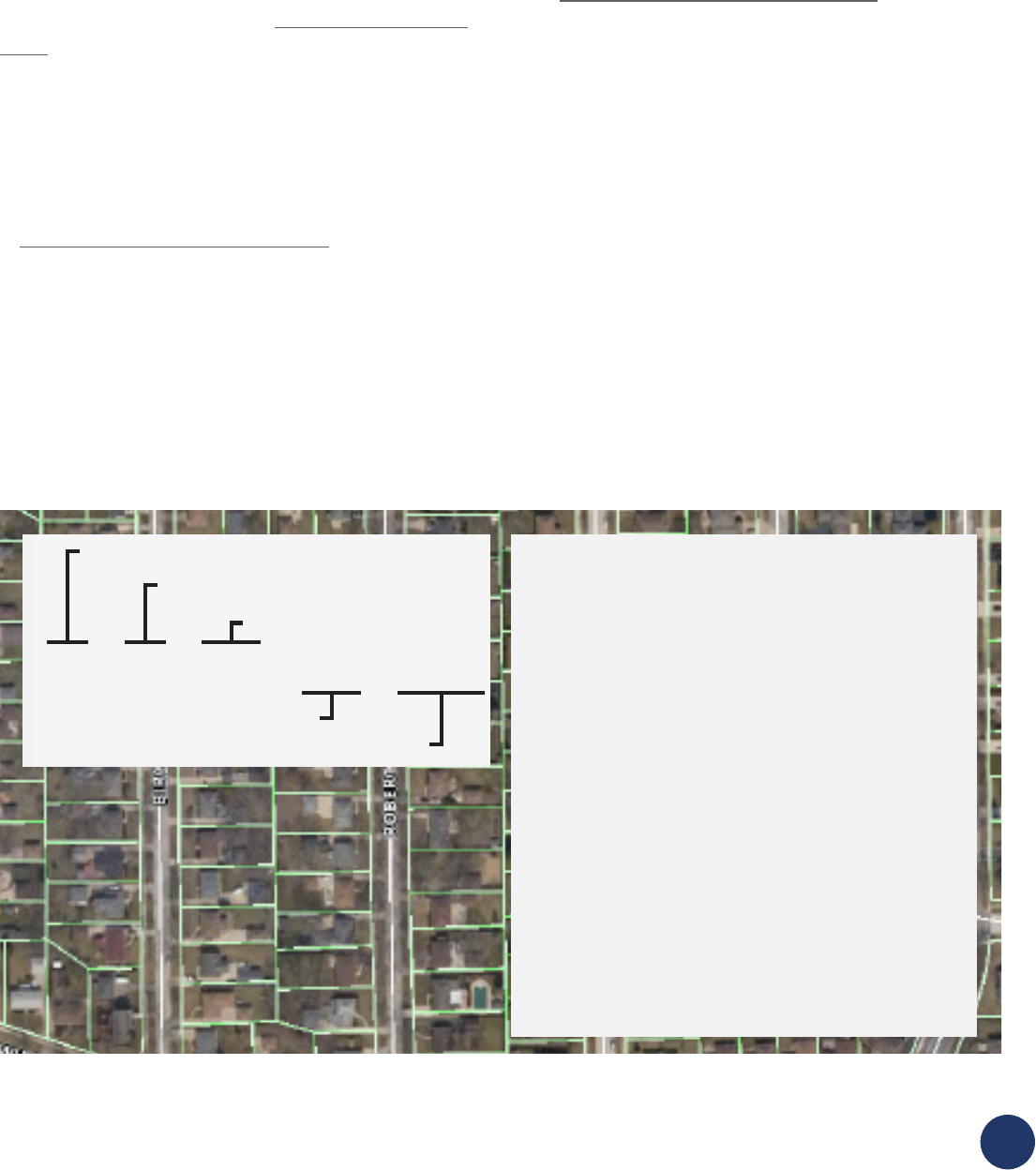
One notable characteristic of property taxes —
not just in the U.S., but throughout the world — is
that all systems are dizzyingly complex, making it
tough for ordinary taxpayers to understand how
they work. For example, the Illinois property tax
code is laid out in more than 200,000 words that
prints out at more than 400 standard-size pages.
Each U.S. state devises its own tax system, often
with variations by region, and other countries
have similarly complex and diverse systems of
property taxation.
A Lincoln Institute working paper examining
European tax systems in 41 countries at the
start of this century found 190 different forms of
taxation. But European and other foreign govern-
ments tend to rely less on property taxes than
they do in the U.S., largely because schools tend
to be funded directly by national governments.
The notable exception is the United Kingdom,
which relies more on property taxation than the
U.S., according to the Tax Foundation.
It’s also worth noting that many states, but not
Illinois, tax “personal property” like cars, boats
and business equipment. The 1970 Illinois
constitution banned personal property taxes. To
make up for the lost revenue, the state assesses
a Personal Property Replacement Tax that ranges
from 0.8% to 2.5% of income on businesses and
utilities.
Of course, the process of determining tax levies,
and each property owner’s share of the tab, is
much more complex than just setting a levy and
then a rate. Assessments, appeals of assess-
ments, tax exemptions, the complex state “equal-
izer,” collections and enforcement all play a role.
BLOCK number
AREA (number sequential township)
SUB-AREA number (section)
* UNIT number for condos and leaseholds
PARCEL number
01—01—301—016—0000
A Word on Property Index Numbers
(PINs)
In Cook County, the Clerk assigns each
property a Property Index Number (PIN), for
both property record and taxation purposes.
PINs are unique 14-digit numbers that
identify each parcel or unit in the county.
When properties are redeveloped, sometimes
they are assigned new PINs. Take the
example of a single-owner building that is
torn down and replaced with a condominium
building. In that case, each separately
owned unit in the building is assigned a PIN.
Conversely, if parcels are combined to build a
new single-owner structure, the multiple PINs
may be consolidated into a single PIN.
8
The Cook County Property
Tax Process
Setting property tax amounts to be billed
is a complex, months-long process that in-
volves at least six government agencies.
(See chart on next page.) The decisions
made by these agencies will determine how
much each property owner is billed. The fol-
lowing pages document the entire process,
from setting property values to sending out
the bills and enforcing collection.

Cook County Assessor
• Determines the market value of each
property
• Considers first appeals
• Approves homeowner exemptions
Cook County Board of Review
• Hears property assessment appeals
• Property owners may appeal this
board's decisions to the Illinois Property
Tax Appeals Board or state courts
Illinois Department of Revenue
• Determines an equalization factor to
make property assessments uniform
throughout the state
Local Governments
• Individual taxing districts, municipalities,
schools, fire districts, libraries, etc., set
their levies, which are the amount of
taxes to be collected
Cook County Clerk
• Determines the tax rates, based on the
total levy
• Applies the rates to assessments,
determining taxes owed
Cook County Treasurer
• Prepares and mails tax bills
• Collects from taxpayers
• Distributes collections to taxing districts
• Conducts tax sales
10

How the Illinois Property Tax System Works
Step 1 — Assessments
Assessments are a key and often misunderstood
part of the property tax process. The assess-
ments — estimates of the market value of a
property — determine how much of the overall
property tax burden within a jurisdiction falls on
each individual property owner.
For example, if a property’s assessed value is
one-tenth of 1% of the total assessed value
within a taxing jurisdiction, the owner of that
property is responsible for paying one-tenth of
1% of the burden. So, if the total tax burden in the
local jurisdiction is $1 million, that hypothetical
property owner would pay $1,000.
An increased assessment alone does not predict
a tax increase:
• If a property’s assessment increases at the
same rate as other properties in a taxing dis-
trict — and local governments don’t increase
the amount of money sought in property taxes
(the levy) — the property’s tax bill will hold
steady.
• If a property assessment goes up, but by a
lesser percentage than other properties in the
taxing district — and local governments don’t
increase their property tax levy — the property’s
tax bill will go down.
• If a property’s assessment increases a greater
percentage than other properties in the taxing
district, that property’s bill will go up — even if
local governments don’t increase their property
tax levy.
County and township assessors in Illinois deter-
mine the value of nearly all properties, based on
the “fair cash value,” which is what the property
would sell for on the open market. To determine
those values, assessors look at real estate
market conditions and, in the case of business
and industrial properties, income derived from the
property being assessed. Farm assessments are
based on “agricultural economic value.”
The Illinois Department of Revenue assesses the
values of railroad properties, pollution-control
facilities, low sulfur dioxide emission coal-fueled
devices and regional water treatment facilities
— all of which are assessed by different meth-
odologies than residential and most business
properties.
In all Illinois counties except for Cook County,
the nal assessment level is 33
1
/
3
% of fair cash
value. In Cook, vacant parcels and residential
properties — including apartment buildings — are
assessed at 10% of fair cash value, while busi-
nesses and industries are assessed at 25% of fair
cash value. As a result, a commercial property
with the same market value as a home would
be taxed two-and-a-half times as much as the
home.
Those assessment differentials, designed to
lessen the burden on homeowners and renters,
were a matter of practice long before 1970,
when they were specically allowed in the Illinois
Constitution. As a result, Chicago has one of
the highest effective commercial and industrial
property tax rates among cities across the nation,
according to the Lincoln Institute and the Min-
nesota Center for Fiscal Excellence.

But treating commercial and
residential properties differently
when conducting assessments
is hardly unique to Cook County.
About half of the states have
different tax rates or assess-
ment levels for different types of
property. In nearly all cases, the
different rates in assessment
levels shift more of the burden
from residents to businesses.
And nearly all states, includ-
ing Illinois, have some type of
“homestead” exemption, which
reduces tax bills on primary
residences even further.
It’s worth noting that in recent
years, investigators and ana-
lysts at the Chicago Tribune
and University of Chicago
,,
among others, have determined
that assessments in Cook
County and across the nation
tend to overvalue lower-priced
properties, particularly in Black
neighborhoods, and undervalue
higher-priced homes, typically
in predominantly white neigh-
borhoods. Those analysts
concluded that practice results
in a regressive and inequitable
property tax system that harms
the poor. (Figure 5)
Homeowners and businesses
can apply for various exemp-
tions and reductions that can
lower a tax bill; the assessor
decides whether to grant them.
Figure 5. Chicago Tribune Article from June
10, 2017, Part of a Four-Part Investigation of
Cook County Property Tax Issues
12

How the Illinois Property Tax System Works
General Homestead Exemption
This exemption is available to every homeowner
for their primary residence and is by far the most
common. It lowers a property’s equalized assessed
value by $10,000 in Cook County, $8,000 in adjacent
counties and $6,000 in the rest of the state.
Senior Citizens Homestead Exemption
This exemption is available to homeowners who are
age 65 and older for their primary residence. It results
in an $8,000 reduction in equalized assessed value in
Cook and adjacent counties and $5,000 in the rest of
the state.
Senior Citizens Assessment Freeze Homestead Exemption
Homeowners who are 65 or more years old and have an
annual household income of less than $65,000 may apply
for this exemption. The assessed value of the home is
frozen at the level where it stood when the exemption was
rst received — resulting in lower tax bills as other property
assessments rise.
The three most common homeowner exemptions:
65+
Other potential assessment reductions for various types
of property are included in Appendix I.
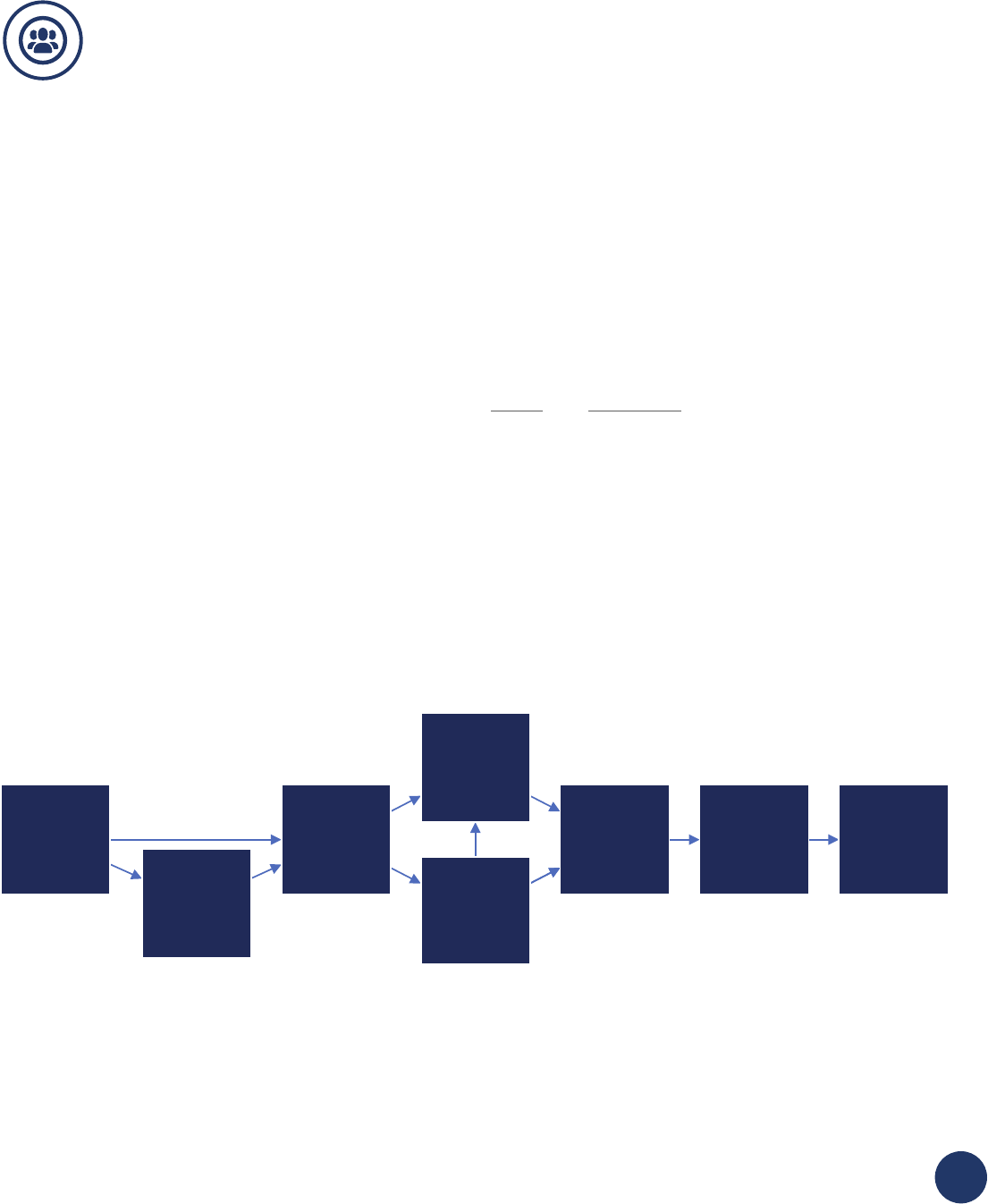
C
O
O
K
C
O
U
N
T
Y
B
O
A
R
D
O
F
R
E
V
I
E
W
Step 2 — Appeals
Once assessments are complete, property
owners are notied of the new assessment
values.
Property owners have 30 days to appeal (chal-
lenge) their assessments at their Assessor’s
Oce. In some jurisdictions, an appeal at that
level is informal; in others, there’s a formal written
process. To win an appeal, a homeowner typi-
cally has to prove their property was assessed
at a higher value than comparable properties.
Businesses also can contest their assessments,
using comparisons, occupancy level and income
generation.
If the property owner does not appeal to the
assessor or is dissatised with the assessor’s
appeal decision, the homeowner can le an
appeal with the county Board of Review.
If a property owner is not satised with the Board
of Review’s decision, the property owner has
two options: appealing to the state Property Tax
Appeal Board or to a county Circuit Court. It
often takes years to complete an appeal with the
Appeals Board, and Circuit Court proceedings can
be lengthy in some counties. That means prop-
erty owners generally have to pay the taxes based
on the contested assessment while the appeal is
pending. (Figure 6)
It’s also important to note that studies in the
press and academia have concluded that the
appeals process often makes the property tax
system more regressive, given that wealthier
property owners typically have greater where-
withal to le successful appeals.
Property Tax Assesment Appeal Path
New
Assessment
Board of
Review
Appellate
Court
Illinois
Supreme
Court
US
Supreme
Court
Office of
the
Assessor
Property
Tax Appeal
Board
State Court
Figure 6. Diagram of the property tax appeals
process in Illinois
14

How the Illinois Property Tax System Works
Step 3 — Equalization
The Illinois Department of
Revenue uses the assessed
values of property to calculate
state funding for schools,
highways and public assistance,
with property tax-rich districts
getting less state funding. It
also uses them to determine tax
and borrowing limitations within
taxing jurisdictions, because
those limitations are all based
in part on the assessed values
within each jurisdiction.
Those calculations for state
funding, however, would not
result in fair and equitable distri-
bution of state funds if the state
did not adjust the assessment
results produced by assessors
in the state’s 102 counties.
That’s because Cook County
assesses properties at differ-
ent percentages of fair cash
value than the rest of the state
and some assessors under- or
overvalue properties within their
jurisdictions.
In addition, the state is required
to ensure that the property tax
burden is distributed equally
among property owners
throughout Illinois, which can
only be done if all assessments
reflect the same percentage of
fair cash value.
The Illinois Department of
Revenue “equalizes” assess-
ments across the state so
they are uniform at 33
1
/
3
%
of fair cash value. To do that,
the Department of Revenue
conducts an “assessment/sales
ratio study” that compares a
sampling of assessments to
actual sales, to see if assess-
ments were accurate, while
also accounting for the differ-
ing percentages of assessed
values.
So, in counties outside Cook,
where assessors strive to value
all property for tax purposes at
33
1
/
3
%, it’s only when assessors
miss that mark — determined
by the assessment/sales ratio
study — that adjustments need
to be made.
If assessments in a county
or township do hit that mark,
they are simply multiplied by 1,
meaning they don’t change. But
if they fall short of 33
1
/
3
%, they
will be multiplied by a number
slightly greater than one. For
example, in DuPage County —
Illinois’ second-largest county
— the multiplier for bills sent out
in 2021 was 1.034.
The Equalization for every Illinois county
is set by Illinois Department of Revenue in
Springfeild. Photo: Illinois Ofce of Tourism

If assessments as a whole are above 33
1
/
3
%, they
would be multiplied by a number that’s less than
1 — although that is highly unlikely, given that
under-assessments are far more common than
over-assessments.
Cook County, however, is much more complicated
when it comes to setting the equalization factor.
Right from the start, the numbers will fall well
below that 33
1
/
3
% because all residential property
is assessed at 10%, and commercial and indus-
trial properties are assessed at 25%. And, histori-
cally, Cook County has tended to undervalue its
properties as a whole.
As a result, bringing the overall assessment level
in Cook up to 33
1
/
3
% requires that they be mul-
tiplied by a number far greater than 1. In recent
decades the multiplier in Cook has been at least
2, and sometimes higher than 3. (Figure 7)
2.5%
2.5%
2.6%
2.7%
2.7%
2.8%
3.0%
3.4%
3.3%
3.0%
2.8%
2.7%
2.7%
2.7%
2.8%
3.0%
2.9%
2.9%
3.2%
3.0%
2.9%
0.0%
0.5%
1.0%
1.5%
2.0%
2.5%
3.0%
3.5%
4.0%
2002 2006 2010 2014 2018 2022
Multiplier
Tax Year
Cook County Equalization Factors
Figure 7.
16

How the Illinois Property Tax System Works
Step 4 — Setting the Levy
In Illinois, thousands of gov-
ernments — school districts,
municipalities, townships, park
districts, library districts and the
like — each determine annually
the amount they need to collect
from property taxes. Determin-
ing and approving the amount is
known as “setting the levy.”
The amount of the levies set by
local taxing districts determines
whether overall taxes go up or
down. Hypothetically, if every-
one’s assessment increased
by the same percentage in a
given year when the overall
levy increases, taxes will rise
on every property. In reality,
assessments rise by differing
amounts, making the effects
of the overall tax increase vary
from one property owner to
another.
There are state-imposed limits
on how much a taxing jurisdic-
tion can levy, but they tend to
limit increases as opposed to
reducing the overall burden.
The most notable limit comes
from the Illinois Property Tax
Extension Limitation Law,
which restricts tax increases in
non-home rule units of govern-
ment to increases of 5% or the
preceding year’s increase in the
national Consumer Price Index,
whichever is less. The Limita-
tion Law is commonly called the
tax cap.
Although the Limitation Law
applies to all Illinois school dis-
tricts, which account for more
than half the overall property
tax burden, the law does not
apply to home rule municipal
governments — which are given
more independence to make
governing decisions, including
those involving taxation. In Cook
County, 90 of 135 municipalities
have home rule powers.
A municipality is granted home
rule authority when its popula-
tion tops 25,000 or voters in
a referendum agree to make
the municipality a home rule
jurisdiction. Voters also can
remove home rule authority via
referendum.
Once the local governments
vote to approve their budgets
and set their levies, the levy
amounts are sent to the County
Clerk.
Evanston is one of the 90 home rule com-
munites in Cook County. These communities
have more independence to make governing
decisions, including those involving taxation.
Photo Credit
Chicago’s North Shore CVB

Step 5 — Extending the Levy
The County Clerk ensures that the levies submitted by each government don’t exceed the limits under
the tax cap law. The Clerk also applies the equalization factor to the nal assessed values, before the
Assessor applies the exemptions.
Once the exemptions are applied, the Clerk determines the “adjusted equalized assessed value” using
this formula:
Next, the Clerk takes the levies approved by local governments within each of their taxing districts
and divides them by the adjusted equalized assessed value in each of their districts. The result is the
rate, or the number by which each property’s adjusted equalized assessed value must be multiplied to
raise the funds sought by the taxing district:
The Clerk then ensures the rates for each district do not exceed the maximum amounts allowed by
state law for each taxing agency. Once that’s done, the Clerk adds up the rates that apply to each
individual property in the county.
The result is the “aggregate rate,” commonly called the “composite rate.” The aggregate rate is then
multiplied by the assessed value of each property to determine the amount of tax owed:
The Clerk sends the results to the County Treasurer.
(
Assessed
Value
Equalization
Factor
)
-
Exemptions
=
Adjusted
Equalized
Assessed
Value
Levy
=
Tax
Rate
Adjusted Equalized
Assessed Value
Aggregated
Tax Rate
Adjusted Equalized
Assessed Value
=
Total
Tax
18

How the Illinois Property Tax System Works
The Treasurer uses the data provided by the Clerk
to prepare the tax bills, which offer a detailed
breakdown of how much each property owner is
being billed by the governments that serve them.
The bills are mailed in two installments. (Figure 8)
$ 5,114.99
By 10/01/23 (on time)
2022 Second Installment Property Tax Bill
ClassificationTownship(Payable In)Tax YearCodeVolumeProperty Index Number (PIN)
2-03LYONS202320222103808018-13-206-015-0000
12/02/23 - 01/01/22OR11/02/23 - 12/01/23OR10/02/23 - 11/01/23
$5,345.15$5,268.43$5,191.71
2021 TaxPension2022 %2022 Rate2022 TaxTaxing District
MISCELLANEOUS TAXES
1.930.09%0.0125.68Des Plaines Valley Mosq Abate Dist Lyons
53.6919.872.83%0.378178.90Metro Water Reclamation Dist of Chicago
81.295.204.00%0.534252.74Summit Public Library District
75.3618.933.67%0.490231.91Summit Park District
212.2710.59%1.414669.23Miscellaneous Taxes Total
SCHOOL TAXES
54.242.63%0.351166.12Moraine Valley College 524 Palos Hills
572.3743.5424.19%3.2261,526.83Argo Community HS District 217 (Summit)
921.15145.3041.45%5.5282,616.35Summit School District 104
1,547.7668.27%9.1054,309.30School Taxes Total
MUNICIPALITY/TOWNSHIP TAXES
313.72346.4416.10%2.1471,016.15Village of Summit
12.840.60%0.08037.86Lyons Mental Health
5.660.27%0.03617.04Road & Bridge Lyons
0.550.02%0.0031.42General Assistance Lyons
8.280.30%0.04018.93Town of Lyons
341.0517.29%2.3061,091.40Municipality/Township Taxes Total
COOK COUNTY TAXES
8.140.940.43%0.05827.45Cook County Forest Preserve District
4.140.00%0.0000.00Consolidated Elections
37.9641.172.06%0.272128.76County of Cook
18.490.99%0.13262.47Cook County Public Safety
6.210.37%0.04923.19Cook County Health Facilities
74.943.85%0.511241.87Cook County Taxes Total
2,176.02100.00%13.3366,311.80(Do not pay these totals)
16,961
2021 Assessed Value
146,830
2022 Property Value
10%
X2022 Assessment Level
14,683
2022 Assessed Value
3.2234
X2022 State Equalizer
2022 Equalized Assessed Value (EAV)
47,329
13.336%
X2022 Local Tax Rate
2022 Total Tax Before Exemptions
6,311.80
2022 Total Tax Before Exemptions
6,311.80
Homeowner's Exemption
.00
Senior Citizen Exemption
.00
Senior Freeze Exemption
.00
2022 Total Tax After Exemptions
6,311.80
First Installment
1,196.81
Second Installment +
5,114.99
Total 2022 Tax (Payable in 2021)
6,311.80
5519 S 72ND CT
SUMMIT IL 60501 2205
CRONCIASF J RBIUAN
3453 S ZELVINA AVE
CHICAGO IL 60638-1430
Property Index Number (PIN)
18-13-206-015-0000
T1LG
Volume
080
$ 5,114.99
By 10/01/23 (on time)
If paying later, refer to amounts above.
Use of this coupon authorizes the Treasurer's Oce to
reduce the check amount to prevent overpayment. Include
only one check and one coupon per envelope.
00202202005181320601500001008922400005191713000052684350000534515200005114995
20-18132060150000-0 20 4 1093135
DDTDFFTTTDTATFTDFTAAADDTTDDFDTTTTTADATDAADDAFDAFFAATTFDDDDTFDTFAA
FRANCISCO J URBINA
OR CURRENT OWNER
5155 S MELVINA AVE
CHICAGO IL 60638-1430
145--41691
COOK COUNTY TREASURER
PO BOX 805436
CHICAGO IL 60680-4155
ADFAFDTATDAFDATFAFTTFATATDTTFDDDDADDFDTADADAFFTAFDFTFATDAFDAFAAFA
18132060150000/0/20/F/0000511499/2
DETACH & INCLUDE WITH PAYMENT
TOTAL PAYMENT DUE
IMPORTANT PAY MENT MESSAGES
MAILI NG ADDRE SS
PROPER TY LOCATI ON
TAX CALCULATOR IMPORTAN T MESSAGES
TAXING DISTRICT DEBT AND FINANCIAL DATA
SN 0020230100 RTN 500001075 AN (see PIN) TC 008911
16-29-204-
Amount Paid
$
Include name, PIN, address, phone and email on check
payable to “Cook County Treasurer.”
Internal use only
IF PAYING AFTER
03/01/24, PLEASE PAY
OR OR
$ 10,984.40
By 03/01/24 (on time)
2023 First Installment Property Tax Bill
ClassificationTownship(Payable In)Tax YearCodeVolumeProperty Index Number (PIN)
3-15CICERO202220231500104516-29-204-
05/02/24 - 06/01/2404/02/24 - 05/01/2403/02/24 - 04/01/24
$11,478.71$11,313.94$11,149.17
% of Pension and
Healthcare Costs
Taxing Districts
Can Pay
Amount of
Pension and
Healthcare
Shortage
Pension and
Healthcare Amounts
Promised by Your
Taxing Districts
Money Owed by
Your Taxing
DistrictsYour Taxing Districts
58.79%$1,219,143,000$2,958,492,000$3,294,323,000Metro Water Reclamation Dist of Chicago
101.68%-$67,512$4,022,629$2,652,196Clyde Park District Cicero
100.00%$0$14,808,702$15,685,457Morton Community College 527 (Cicero)
65.57%$71,138,190$206,593,487$215,607,651J Sterling Morton HS 201 (Berwyn/Cicero)
38.41%$304,237,528$493,940,699$34,866,294Cicero School District 99
30.64%$442,101,126$637,407,413$339,609,093Town of Cicero
39.19%$328,420,280$540,107,634$233,103,051Cook County Forest Preserve District
42.60%$15,481,971,961$26,972,931,181$7,595,772,042County of Cook
$17,846,944,573$31,828,303,745$11,731,618,784Total
PAY YOUR TAXES ONLINE
at cookcountytreasurer.com from your bank account or credit card
19,971.64
2022 TOTAL TAX
55%
X2023 ESTIMATE
10,984.40
=2023 TOTAL TAX
The First Installment amount is 55% of last year's total taxes. All
exemptions, such as homeowner and senior exemptions, will be
reflected on your Second Installment tax bill.
W 22ND PL
CICERO IL 60804
PO BOX
BERWYN IL 60402
Property Index Number (PIN)
T1LG
Volume
045
$ 10,984.40
By 03/01/24 (on time)
If paying later, refer to amounts above.
Use of this coupon authorizes the Treasurer's Oce to
reduce the check amount to prevent overpayment. Include
only one check and one coupon per envelope.
002023010031629204000003008911200010984400000111491700001131394900011478718
20 16-29-204 0 21 0 0405652
FTAAFFFTAATDFFFTTTDATTFTTDFTDATDTFATDAFFFDAAAAADTFTFFTFATADAFDDDA
OR CURRENT OWNER
PO BOX
BERWYN IL 60402
MAIN2--1--1
COOK COUNTY TREASURER
PO BOX 805438
CHICAGO, IL 60680-4116
ADFAFDTATDAFDATFAFTTFATATDTTFDDDDADDFDTADADAFFTAFDFTFATDAFDAFAAFA
162920400000/0/21/E/0001098440/1
First Installment Second Installment
Cook County Property Tax Bills
Step 6 — Collection and Distribution
Figure 8.
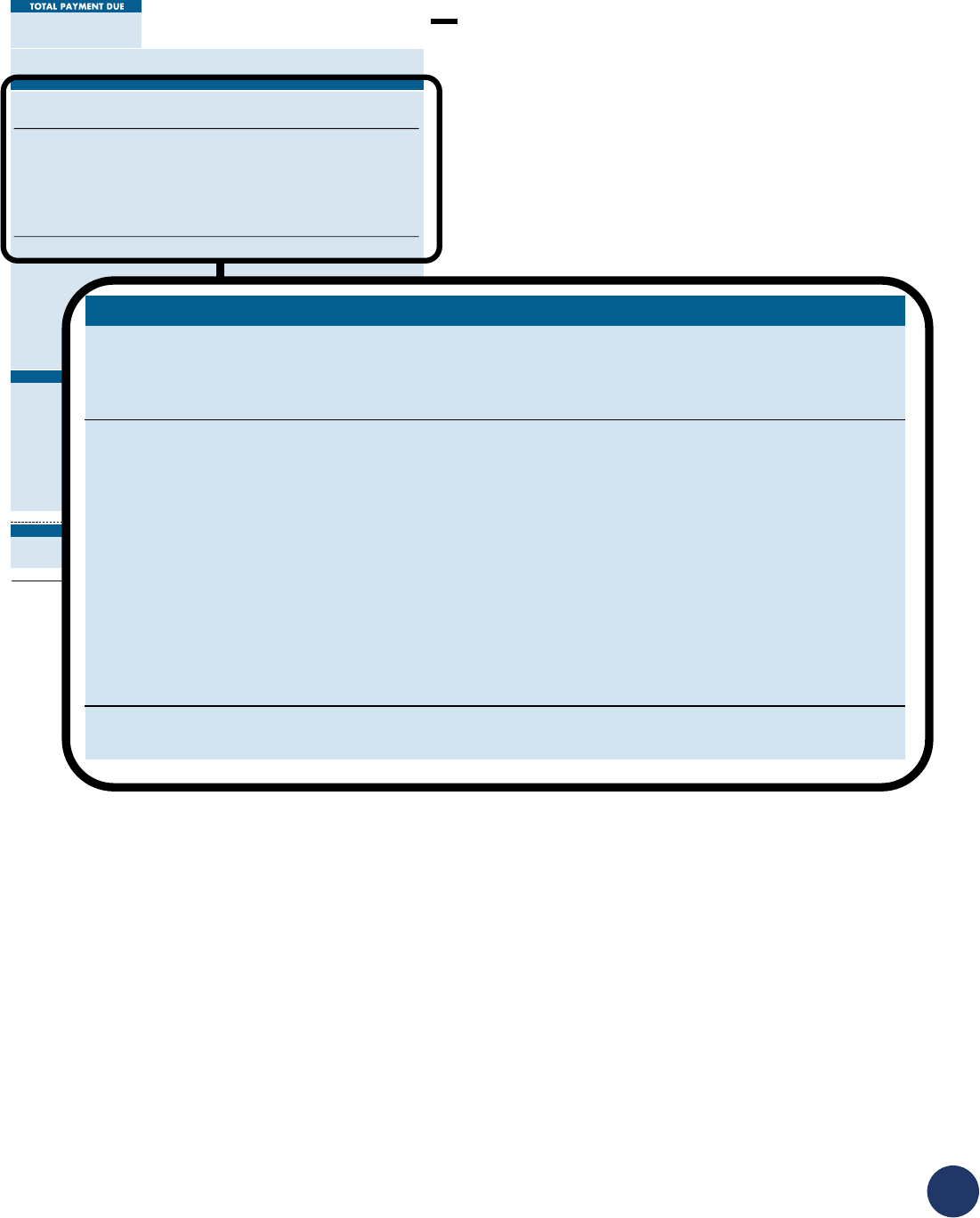
Figure 9. Section of a rst installment Cook County property tax bill
In Cook County, the rst installment is
typically due on March 1. This bill also
includes a breakdown of local govern-
ment debt and unfunded liabilities.
(Figure 9)
DETACH & INCLUDE WITH PAYMENT
TOTAL PAYMENT DUE
IMPORTANT P AY MENT MESSAGES
MAILI NG ADDRE SS
PROPER TY LOCATI ON
TAX CALCULATOR IMPORTAN T MESSAGES
TAXING DISTRICT DEBT AND FINANCIAL DATA
SN 0020230100 RTN 500001075 AN (see PIN) TC 008911
16-29-204-
Amount Paid
$
Include name, PIN, address, phone and email on check
payable to “Cook County Treasurer.”
Internal use only
IF PAYING AFTER
03/01/24, PLEASE PAY
OR OR
$ 10,984.40
By 03/01/24 (on time)
2023 First Installment Property Tax Bill
ClassificationTownship(Payable In)Tax YearCodeVolumeProperty Index Number (PIN)
3-15CICERO202220231500104516-29-204-
05/02/24 - 06/01/2404/02/24 - 05/01/2403/02/24 - 04/01/24
$11,478.71$11,313.94$11,149.17
% of Pension and
Healthcare Costs
Taxing Districts
Can Pay
Amount of
Pension and
Healthcare
Shortage
Pension and
Healthcare Amounts
Promised by Your
Taxing Districts
Money Owed by
Your Taxing
DistrictsYour Taxing Districts
58.79%$1,219,143,000$2,958,492,000$3,294,323,000Metro Water Reclamation Dist of Chicago
101.68%-$67,512$4,022,629$2,652,196Clyde Park District Cicero
100.00%$0$14,808,702$15,685,457Morton Community College 527 (Cicero)
65.57%$71,138,190$206,593,487$215,607,651J Sterling Morton HS 201 (Berwyn/Cicero)
38.41%$304,237,528$493,940,699$34,866,294Cicero School District 99
30.64%$442,101,126$637,407,413$339,609,093Town of Cicero
39.19%$328,420,280$540,107,634$233,103,051Cook County Forest Preserve District
42.60%$15,481,971,961$26,972,931,181$7,595,772,042County of Cook
$17,846,944,573$31,828,303,745$11,731,618,784Total
PAY YOUR TAXES ONLINE
at cookcountytreasurer.com from your bank account or credit card
19,971.64
2022 TOTAL TAX
55%
X2023 ESTIMATE
10,984.40
=2023 TOTAL TAX
The First Installment amount is 55% of last year's total taxes. All
exemptions, such as homeowner and senior exemptions, will be
reflected on your Second Installment tax bill.
W 22ND PL
CICERO IL 60804
PO BOX
BERWYN IL 60402
Property Index Number (PIN)
T1LG
Volume
045
$ 10,984.40
By 03/01/24 (on time)
If paying later, refer to amounts above.
Use of this coupon authorizes the Treasurer's Oce to
reduce the check amount to prevent overpayment. Include
only one check and one coupon per envelope.
002023010031629204000003008911200010984400000111491700001131394900011478718
20 16-29-204 0 21 0 0405652
FTAAFFFTAATDFFFTTTDATTFTTDFTDATDTFATDAFFFDAAAAADTFTFFTFATADAFDDDA
OR CURRENT OWNER
PO BOX
BERWYN IL 60402
MAIN2--1--1
COOK COUNTY TREASURER
PO BOX 805438
CHICAGO, IL 60680-4116
ADFAFDTATDAFDATFAFTTFATATDTTFDDDDADDFDTADADAFFTAFDFTFATDAFDAFAAFA
162920400000/0/21/E/0001098440/1
First Installment Property Tax Bill
Taxing District Debt and Financial Data
Your Taxing Districts
Money Owed by
Your Taxing
Districts
Pension and
Healthcare
Amounts Promised
by Your Taxing
Districts
Amount of
Pension and
Healthcare
Shortage
% of Pension
and Healthcare
Costs Taxing
Districts
Can Pay*
Metro Water Reclamation Dist of Chicago $3,294,323,000 $2,958,492,000 $1,219,143,000 58.79%
Clyde Park District Cicero
$2,652,196 $4,022,629 -$67,512 101.68%
Morton Community College 527 (Cicero)
$15,685,457 $14,808,702 $0 100.00%
J Sterling Morton HS 201 (Berwyn/Cicero)
$215,607,651 $206,593,487 $71,138,190 65.57%
Cicero School District 99
$34,866,294 $493,940,699 $304,237,528 38.41%
Town of Cicero
$339,609,093 $637,407,413 $442,101,126 30.64%
Cook County Forest Preserve District
$233,103,051 $540,107,634 $328,420,280 39.19%
County of Cook
$7,595,772,042 $26,972,931,181 $15,481,971,961 42.60%
Total $11,731,618,784 $31,828,303,745 $17,846,944,573
TAXING DISTRICT DEBT AND FINANCIAL DATA
* Pension and Healthcare liabilities are calculated on a modified accrual basis.
2023 2024
20
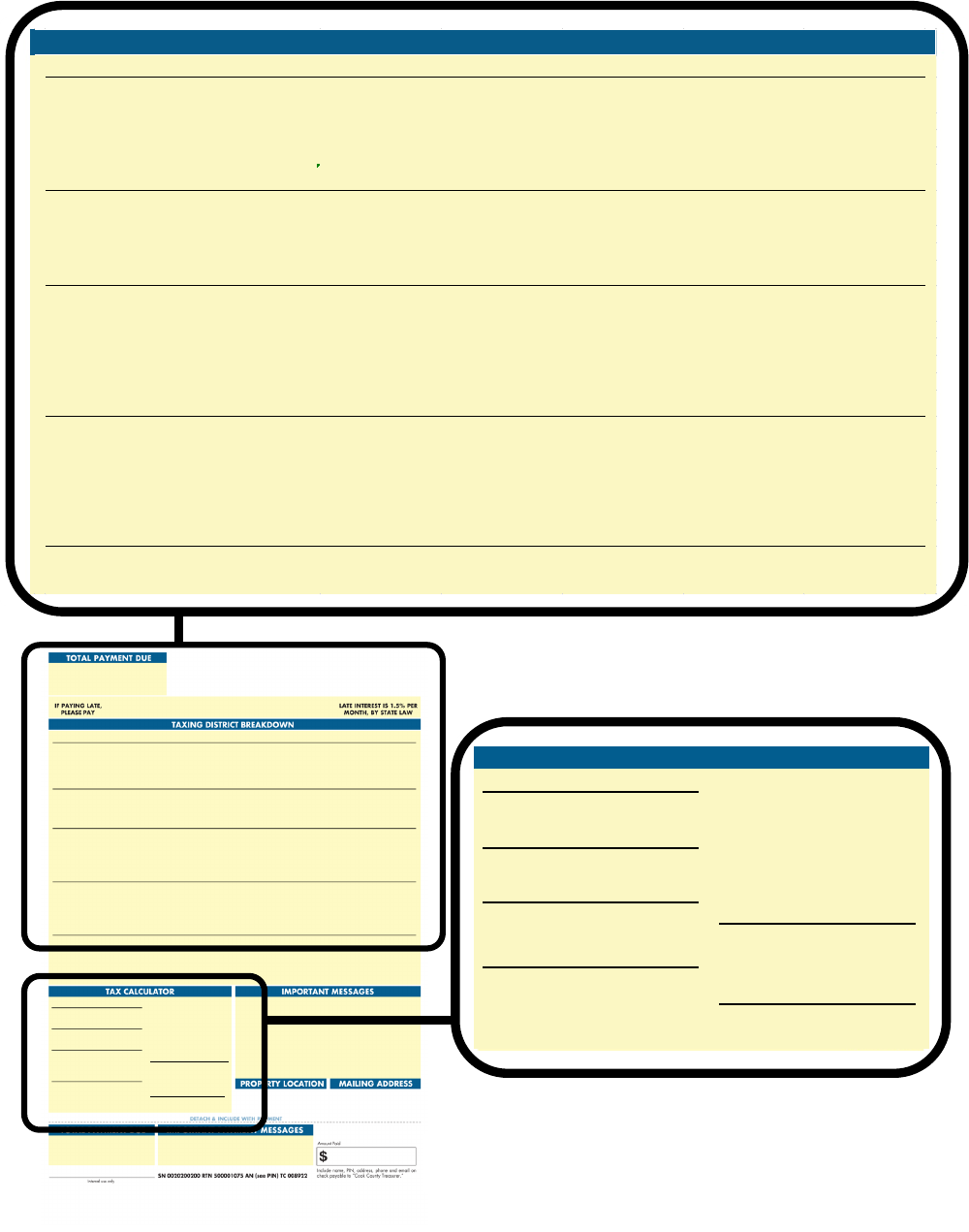
How the Illinois Property Tax System Works
$ 5,114.99
By 10/01/23 (on time)
2022 Second Installment Property Tax Bill
ClassificationTownship(Payable In)Tax YearCodeVolumeProperty Index Number (PIN)
2-03LYONS202320222103808018-13-206-015-0000
12/02/23 - 01/01/22OR11/02/23 - 12/01/23OR10/02/23 - 11/01/23
$5,345.15$5,268.43$5,191.71
2021 TaxPension2022 %2022 Rate2022 TaxTaxing District
MISCELLANEOUS TAXES
1.930.09%0.0125.68Des Plaines Valley Mosq Abate Dist Lyons
53.6919.872.83%0.378178.90Metro Water Reclamation Dist of Chicago
81.295.204.00%0.534252.74Summit Public Library District
75.3618.933.67%0.490231.91Summit Park District
212.2710.59%1.414669.23Miscellaneous Taxes Total
SCHOOL TAXES
54.242.63%0.351166.12Moraine Valley College 524 Palos Hills
572.3743.5424.19%3.2261,526.83Argo Community HS District 217 (Summit)
921.15145.3041.45%5.5282,616.35Summit School District 104
1,547.7668.27%9.1054,309.30School Taxes Total
MUNICIPALITY/TOWNSHIP TAXES
313.72346.4416.10%2.1471,016.15Village of Summit
12.840.60%0.08037.86Lyons Mental Health
5.660.27%0.03617.04Road & Bridge Lyons
0.550.02%0.0031.42General Assistance Lyons
8.280.30%0.04018.93Town of Lyons
341.0517.29%2.3061,091.40Municipality/Township Taxes Total
COOK COUNTY TAXES
8.140.940.43%0.05827.45Cook County Forest Preserve District
4.140.00%0.0000.00Consolidated Elections
37.9641.172.06%0.272128.76County of Cook
18.490.99%0.13262.47Cook County Public Safety
6.210.37%0.04923.19Cook County Health Facilities
74.943.85%0.511241.87Cook County Taxes Total
2,176.02100.00%13.3366,311.80(Do not pay these totals)
16,961
2021 Assessed Value
146,830
2022 Property Value
10%
X2022 Assessment Level
14,683
2022 Assessed Value
3.2234
X2022 State Equalizer
2022 Equalized Assessed Value (EAV)
47,329
13.336%
X2022 Local Tax Rate
2022 Total Tax Before Exemptions
6,311.80
2022 Total Tax Before Exemptions
6,311.80
Homeowner's Exemption
.00
Senior Citizen Exemption
.00
Senior Freeze Exemption
.00
2022 Total Tax After Exemptions
6,311.80
First Installment
1,196.81
Second Installment +
5,114.99
Total 2022 Tax (Payable in 2021)
6,311.80
5519 S 72ND CT
SUMMIT IL 60501 2205
CRONCIASF J RBIUAN
3453 S ZELVINA AVE
CHICAGO IL 60638-1430
Property Index Number (PIN)
18-13-206-015-0000
T1LG
Volume
080
$ 5,114.99
By 10/01/23 (on time)
If paying later, refer to amounts above.
Use of this coupon authorizes the Treasurer's Oce to
reduce the check amount to prevent overpayment. Include
only one check and one coupon per envelope.
00202202005181320601500001008922400005191713000052684350000534515200005114995
20-18132060150000-0 20 4 1093135
DDTDFFTTTDTATFTDFTAAADDTTDDFDTTTTTADATDAADDAFDAFFAATTFDDDDTFDTFAA
FRANCISCO J URBINA
OR CURRENT OWNER
5155 S MELVINA AVE
CHICAGO IL 60638-1430
145--41691
COOK COUNTY TREASURER
PO BOX 805436
CHICAGO IL 60680-4155
ADFAFDTATDAFDATFAFTTFATATDTTFDDDDADDFDTADADAFFTAFDFTFATDAFDAFAAFA
18132060150000/0/20/F/0000511499/2
Second Installment
Property Tax Bill
Tax Calculator
Taxing District Breakdown
2021 Assessed Value 16,961 2022 Total Tax Before Exemption
s
Homeowner's Exemption
.00
Senior Citizen Exemption
2023 Assessed Value 14,683 .00
Senior Freeze Exemption
2022 State Equalizer x 3.2234 .00
2022 Equalized Assessed Value (EAV)
47,329
2022 Total Tax Before Exemptions
2022 Local Tax Rate x 13.336% 6,311.81
2022 Total Tax Before Exemptions First Installment 2,296.81
Second Installment +
4,015.00
Total 2022 Tax (Payable in 2023)
6,311.81
$6,311.81
TAX CALCULATOR
6,311.81
2022 Property Value 146,830
2022 Assessment Level
x
10%
Taxing District 2020 Tax 2020 Rate 2020 % Pension 2019 Tax
MISCELLANEOUS TAXES
Des Plaines Valley Mosq Abate Dist Lyons
5.68 0.012 0.09% 1.93
Metro Water Reclamation Dist of Chicago 178.90 0.378 2.83% 19.87 53.69
Summit Public Library District 252.74 0.534 4.00% 5.20 81.29
Summit Park District 231.91 0.490 3.67% 18.93 75.36
Miscellaneous Taxes Total 669.23 1.414 10.59% 212.27
SCHOOL TAXES
Moraine Valley College 524 Palos Hills
166.12 0.351 2.63% 54.24
Argo Community HS District 217 (Summit) 1,526.83 3.226 24.19% 43.54 572.37
Summit School District 104 2,616.35 5.528 41.45% 145.30 921.15
School Taxes Total 4,309.30 9.105 68.27% 1,547.76
MUNICIPALITY/TOWNSHIP TAXES
Village of Summit
1,016.15 2.147 16.10% 346.44 313.72
Lyons Mental Health 37.86 0.080 0.60% 12.84
Road & Bridge Lyons 17.04 0.036 0.27% 5.66
General Assistance Lyons 1.42 0.003 0.02% 0.55
Town of Lyons 18.93 0.040 0.30% 8.28
Municipality/Township Taxes Total 1,091.40 2.306 17.29% 341.05
COOK COUNTY TAXES
Cook County Forest Preserve District
27.45 0.058 0.43% 0.94 8.14
Consolidated Elections 0.00 0.000 0.00% 4.14
County of Cook 128.76 0.272 2.06% 41.17 37.96
Cook County Public Safety 62.47 0.132 0.99% 18.49
Cook County Health Facilities 23.19 0.049 0.37% 6.21
Cook County Taxes Total 241.87 0.511 3.85% 74.94
(Do not pay these totals)
6,311.80 13.336 100% 2,176.02
TAXING DISTRICT BREAKDOWN
Figure 10. Sample of a second installment Cook County property tax bill
Cook County’s second installment is typically
due on Aug. 1. This bill breaks down how much
each agency is taxing the property owner and
how the taxes are calculated. (Figure 10)
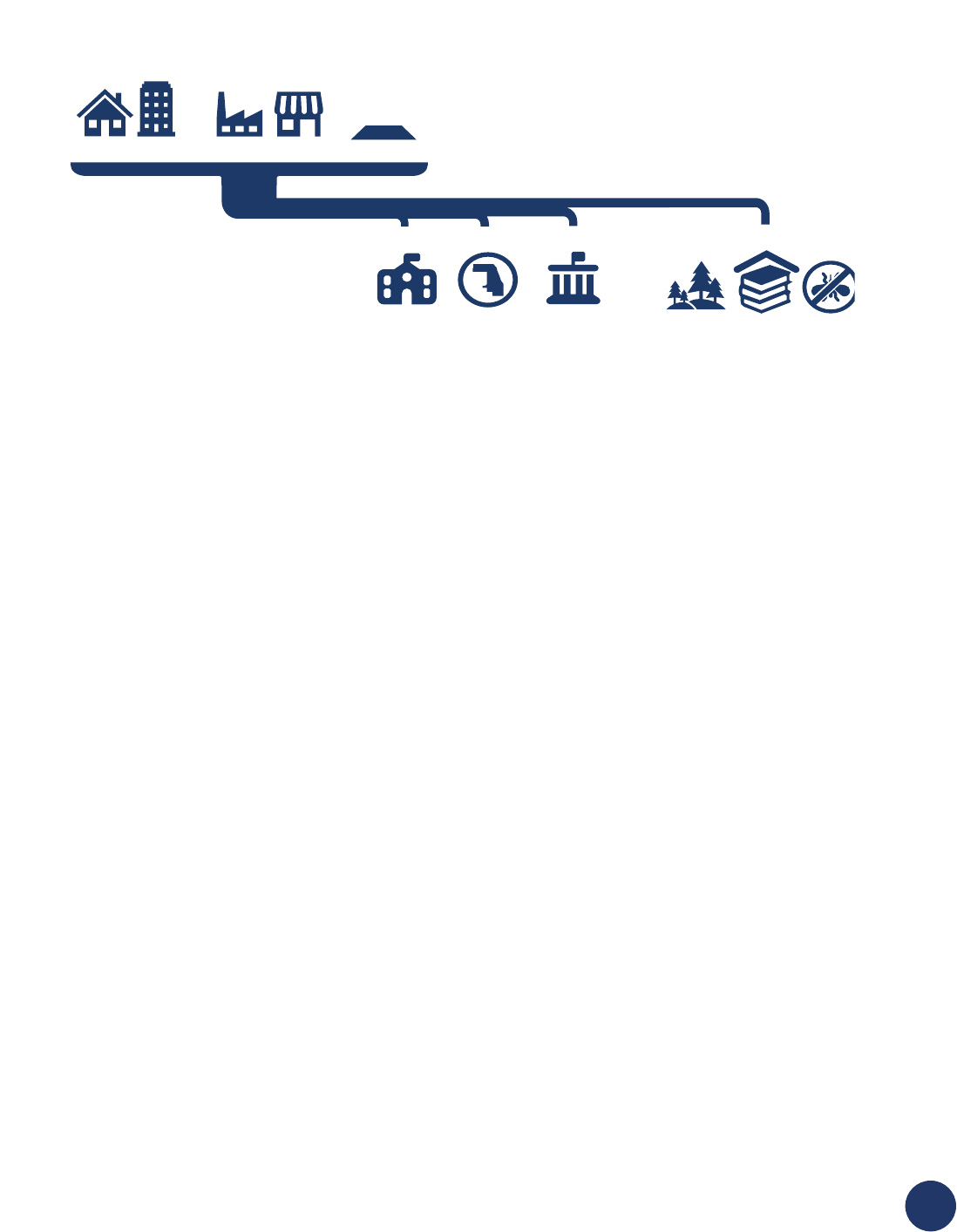
Residential Commercial
Schools County City / Village Other taxing agencies
Vacant
Property Owners Pay
The Treasurer Distributes
Money to Taxing Districts
Collection and Distribution
Figure 11. The Treasurer is responsible for the collection and distribution of county funds
Collection and Distribution
Taxpayers who believe their bills are not fair can
dispute their tax bills by ling a complaint in
Circuit Court, but they must pay their taxes in the
meantime. They can challenge the tax rates, the
levy or raise other constitutional questions at this
stage.
The Treasurer records the payments and de-
posits the collected funds into the appropriate
accounts for each taxing district. Outside Cook
County, collected taxes plus any interest earned
on investing the received payments must be
deposited in taxing district accounts within 30
days of the payment due date and every 30 days
thereafter as money continues to come in. In
Cook County, taxes and interest earned are re-
quired to be disbursed starting on June 1 and the
rst day of each month thereafter, but the Cook
County Treasurer distributes funds as they come
in. (Figure 11).
22
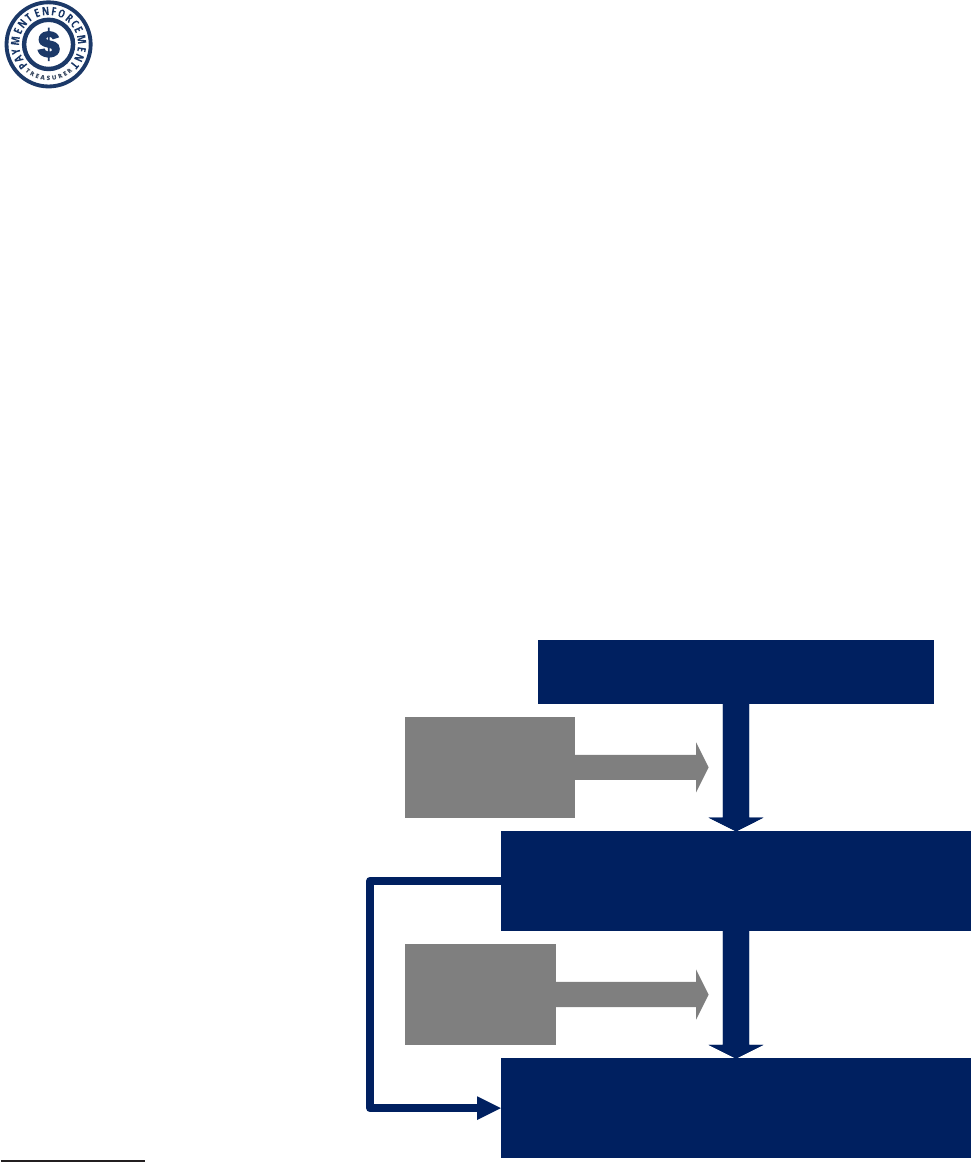
How the Illinois Property Tax System Works
Figure 12. Diagram of the process and penalties accrued when a tax buyer purchases a tax lien
Step 7 — Payment Enforcement
In Cook County, unpaid taxes
accrue interest charges
of 0.75%, or 9% per year, a
reduced rate that went into
effect in March 2024.
9
In the
rest of Illinois, unpaid tax bills
are charged interest of 1.5% a
month, or 18% per year.
Cook County property tax bills
that are not fully paid within 13
months of the second install-
ment due date are offered by
the county Treasurer at the
Annual Tax Sale. (Outside Cook
County, the Annual Tax Sale
takes place four months after
the second installment due
date.)
At the Tax Sale, bidders — often
institutional investors known as
tax buyers — submit the interest
rate they would charge to the
property owner for paying their
delinquent taxes and penalties.
The interest bid cannot exceed
9%. The tax buyer that submits
the lowest interest rate wins.
9 Until March 2024, the monthly interest
rate on late Cook County taxes was 1.5%,
or 18% per year.
That buyer then pays the taxes
and penalties, and a lien is
placed on the property for the
paid amount.
Homeowners and owners of
multi-unit buildings with no
more than six units whose taxes
are “sold” have 2 ½ years to pay
the Clerk the amount paid plus
the interest. This is called “re-
deeming” the taxes. Owners of
commercial and vacant prop-
erty have one year to redeem
their taxes.
Regardless of property classi-
cation, the tax buyer can opt to
extend the redemption period to
a maximum of three years.
The interest rate that the tax
buyer charges is applied every
six months. For example, a 3%
charge would rise to 6% after
six months, 9% after a year and
so on. In the majority of cases,
that increase is meaningless,
Second Installment Tax Due Date
Tax Lien Purchased at Annual Tax Sale
Tax Buyer Pays Next Missed Taxes — 12%
Interest, Owed to Tax Buyer, Added
0 to 9% (as bid by tax
buyer) Interest
Owed
to Tax Buyer
Every 6
Months
0.75 % Simple Interest
Owed Monthly to the
County for 13 Months
(9% Annually)
Tax Liens Purchased by a Tax Buyer
at Annual Tax Sale in Cook County

because tax buyers more often
than not submit 0% interest
bids, guring they’ll make a
prot later in the process.
That prot comes when tax
buyers exercise their right to pay
taxes that go unpaid on proper-
ties after the buyers won them
at the Annual Tax Sale. An im-
mediate 12% interest is applied
to subsequent payments made
by the tax buyer. (Figure 12)
If a property owner fails to
redeem their taxes in time, a tax
buyer can go to Circuit Court
and seek ownership of the
property.
When a property’s taxes are
offered at sale, but not sold,
the taxes are “forfeited” to the
county, which then has the right
to take the property if all taxes
and fees aren’t paid within 2 ½
years. A monthly interest rate
of .75% continues to accrue.
(Figure 13)
If a Cook County property owner
has not paid all or part of their
property tax bills for three years
in a 20-year period, and those
taxes remain delinquent, the
property may go to the biennial
Scavenger Sale — the state’s
last-ditch effort to restore
properties to productive use.
These sales, which were made
optional when the Illinois Prop-
erty Tax Code was amended in
2023, also are conducted by the
Cook County Treasurer.
Figure 13. Diagram of the penalties accrued by forfeited tax lien properties
2 ½ Years
Second Installment Tax Due Date
Forfeited (not sold) at Annual Tax
Sale
0.75 % Simple Interest
Owed Monthly to the
County for 13 Months
(9% Annually)
0.75% Monthly
Interest Continues
County May Take
the Property
Taxes Left Unpurchased at an
Annual Tax Sale in Cook County
A Treasurer’s Ofce study
found that the Scavenger
Sale failed in its mission to
return properties to produc-
tive use
10
, a conclusion also
reached in a subsequent
study by the University of
Chicago
11
.
A detailed follow-up Scav-
enger Sale study
12
by the
Treasurer’s Ofce found
the majority of properties
offered at the Scavenger
10 (The Pappas Studies, 2020)
https://www.cookcountytreasurer.
com/scavengersalestudy.aspx
11 (Schmidt, 2021) https://harris.
uchicago.edu/news-events/news/
comprehensive-independent-analysis-
cook-county
12 (The Pappas Studies, 2022)
https://cookcountytreasurer.com/
pdfs/scavengersalestudy/2022scave
ngersalestudy.pdf
Sale that were located in
areas mapped by the federal
government in 1940 were
redlined, meaning they were
in areas where the federal
government sanctioned the
denial of conventional mort-
gages. That forced minority
homebuyers into predatory
loans that ultimately led to
urban decay and the Black
exodus from Chicago.
13
13 (The Pappas Studies, 2022)
https://cookcountytreasurer.com/
pdfs/scavengersalestudy/2022scave
ngersalestudy.pdf
24
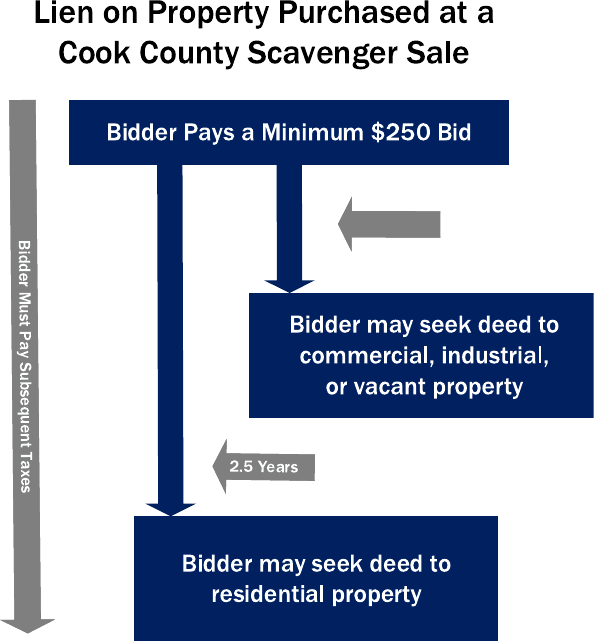
How the Illinois Property Tax System Works
That study recommended
making the Scavenger Sale
optional, as well as cutting in
half interest rates charged on
delinquent Cook County prop-
erty tax payments. The 2023
Property Tax Code amendment
included those changes.
Should Scavenger Sales no
longer be held, the county could
work out payment plans for
owners of occupied, chronically
tax-delinquent properties, while
selecting non-occupied proper-
ties to take after the redemption
period has expired.
In the Scavenger Sale, private
bidders can offer as little as
$250 for a property tax lien,
and governments can get rst
dibs with no-cash bids. Private
buyers must pay all future taxes
on the property to keep open
their option to eventually seek
a court-ordered deed and take
ownership of the property.
As in the Annual Tax Sale, if a
homeowner doesn’t redeem
within 2 ½ years after their taxes
are sold at the Scavenger Sale,
the buyer can go to deed on the
property. On business, industrial
and vacant properties, buyers
can go to deed after one year.
(Figure 14)
Some buyers, however, back out
of taking an unwanted property
by going to court and seeking
what’s called a sale in error.
Those sales in error are sought
primarily in Annual Sales, where
buyers typically look to make a
prot, not acquire property
A Treasurer’s Ofce study found
that tax buyers — mostly hedge
funds and private equity rms —
use the esoteric sales-in-error
process to back out of deals
in ways not allowed in other
states.
Under sales in error, tax buyers
received refunds of about
$277.6 million, including at least
$27.7 million in interest, during
a seven-year period ending in
September 2022. Of that, 87%
was refunded by local govern-
Figure 14. Diagram of the “Go to Deed” process following a scavenger sale
1 Year
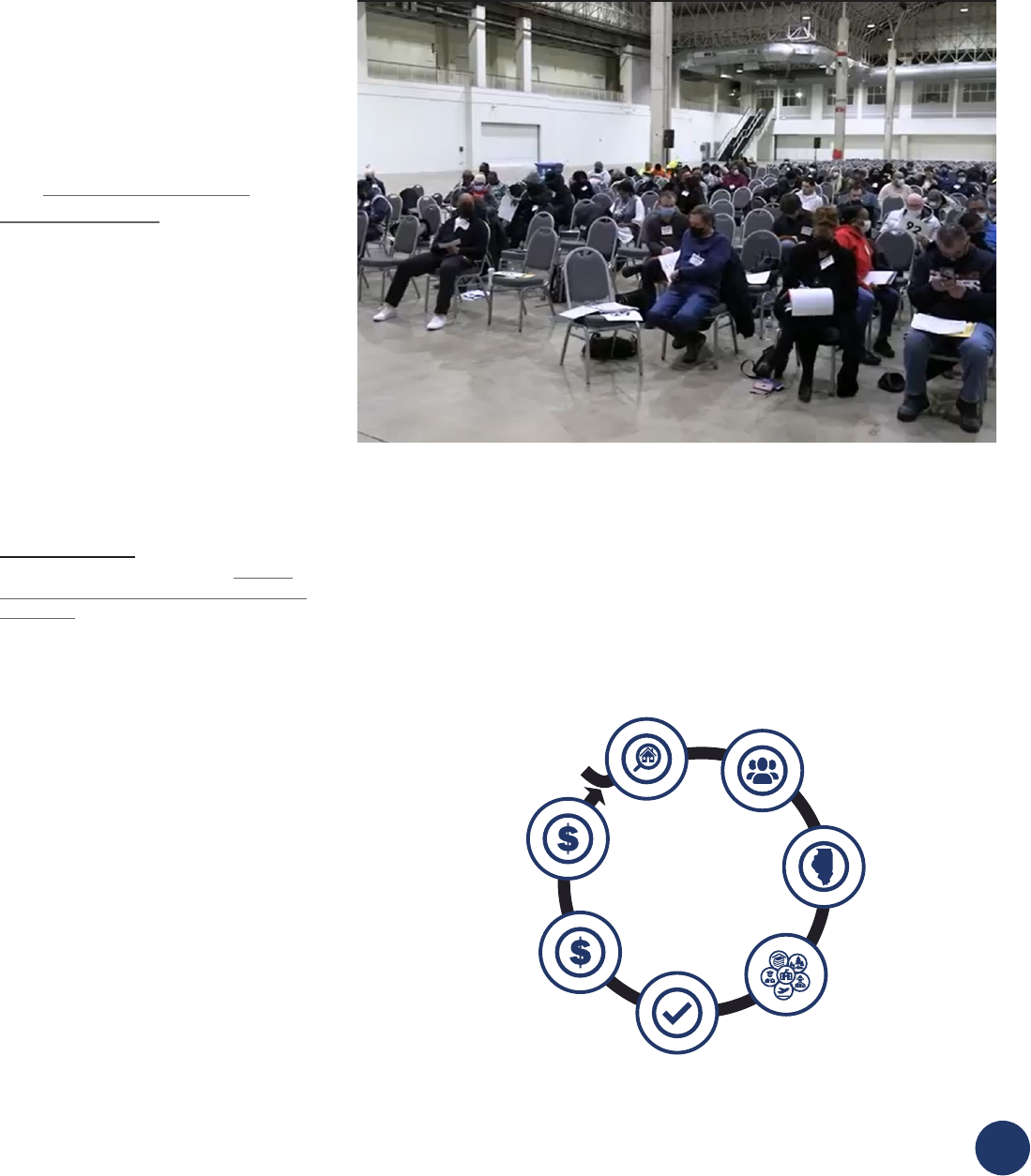
2022 Scavenger Property Sale at Navy Pier
The Cycle Starts Over
Once the bills have gone out and the
vast majority of property owners have
paid, the cycle starts over, with asses-
sors outside Cook County revaluing all
properties again. In Cook County, where
a third of the county is assessed each
year, the Assessor moves on to the next
area.
T
R
E
A
S
U
R
E
R
C
O
L
L
E
C
T
I
O
N
/
D
I
S
T
R
I
B
U
T
I
O
N
T
R
E
A
S
U
R
E
R
P
A
Y
M
E
N
T
E
N
F
O
R
C
E
M
E
N
T
C
O
U
N
T
Y
C
L
E
R
K
E
X
T
E
N
D
T
H
E
L
E
V
Y
B
O
A
R
D
O
F
R
E
V
I
E
W
A
P
P
E
A
L
S
/
R
E
V
I
E
W
S
T
A
T
E
E
Q
U
A
L
I
Z
A
T
I
O
N
D
E
P
A
R
T
M
E
N
T
O
F
R
E
V
E
N
U
E
T
A
X
I
N
G
D
I
S
T
R
I
C
T
S
S
E
T
T
I
N
G
T
H
E
L
E
V
Y
A
S
S
E
S
S
O
R
A
S
S
E
S
S
M
E
N
T
ments serving predominantly
Black and Latino residents
— making it even tougher
for many scally challenged
communities to deliver basic
services.
The Treasurer’s Office
recommended
14
closing
numerous loopholes to reduce
sales in error. Many of those
loopholes were closed with the
passage of the 2023 Property
Tax Code amendments.
14 (The Pappas Studies, 2023) https://
www.cookcountytreasurer.com/siestudy-
links.aspx
Photo Credit
Cook County Treasurer’s Ofce
26

How the Illinois Property Tax System Works
Appendix
Additional Exemptions & Forms of Tax Relief
Long-time Occupant Homestead Exemption
(Cook County only) – This exemption is avail-
able to homeowners with a household income
of $100,000 or less who have lived in the home
for 10 continuous years, or ve years if the
homeowner received government or nonprot
assistance to purchase the home. When this
is granted, annual increases in assessed value
are limited to 7% for households with income
of $75,000 or less and 10% for households
with income higher than $75,000 but less than
$100,000.
Standard Homestead Exemption for Veterans with
Disabilities – This exemption reduces assessed
values for veterans based on the percentage level
of their service-related disability. For homeown-
ers who are at least 70% disabled, the property is
exempt from taxation up to $250,000 of equalized
assessed value. Exemptions are $5,000 of equal-
ized assessed value for people at 50% to 69%
disability, and exemptions of $2,500 are available
to veterans with 30% to 49% disability.
Returning Veterans Homestead Exemption – This
exemption is available to U.S. military veterans
who recently returned from active duty in armed
conflict involving U.S. armed forces. The exemp-
tion applies to the primary residence owned by
the veteran. It reduces equalized assessed value
by $5,000 and lasts for two years.
Veterans with Disabilities Exemption for Specially
Adapted Housing – This exemption is available to
disabled veterans who received federal or non-
prot funding to specially adapt housing to their
needs. This potential exemption can reduce a
property’s assessed value by up to $100,000.
Homestead Exemption for Persons with Dis-
abilities – This exemption allows disabled people
paying property taxes to receive a $2,000 reduc-
tion in their equalized assessed value.

Homestead Improvement Exemption – This ex-
emption is available to homeowners who make
improvements, like adding a room or remodeling
that increases the value of the home. It’s also
available to homeowners who rebuild their home
after a catastrophic event. This exemption is
limited to value added by the improvements,
with a maximum exemption of $75,000 of fair
cash value, which translates into a reduction in
assessed value of $7,500. The exemption expires
after four years.
Natural Disaster Homestead Exemption – This
exemption is for homeowners whose homes had
to be rebuilt after a natural disaster. The amount
of the exemption is equal to the current value of
the rebuilt home minus the value of the home
before it was damaged. The exemption continues
until the property is sold or transferred.
Historic Residence Property Tax Assessment
Freeze – This exemption is available to owners
of homes that are certied as historic residences
when the owner rehabilitates the home. This
exemption freezes the assessment at the level
where it stood before rehabilitation for eight
years, then ramps it up to actual fair cash value
over the next four years.
Full Exemptions for Religious, Charitable or
Educational Organizations – This tax break elimi-
nates taxes on non-prot, religious and educa-
tional properties with the approval of the county
Board of Review and the Illinois Department of
Revenue.
Business Incentive Tax Reductions – The state
of Illinois and many Illinois counties offer various
incentives for businesses that relocate or expand
in their jurisdictions. Typically, these tax breaks
lower the assessment levels for business and
industrial properties below the statutorily required
25% for several years.
Senior Citizens Real Estate Tax Deferral Program
– This allows homeowners who are at least 65
years old and make no more than $65,000 a year
to defer up to $7,500 in tax payments each year.
The state pays the amount deferred and places
a lien on the property. When the home is sold or
transferred, the state collects the money plus 3%
annual interest.
28

How the Illinois Property Tax System Works
Ofces Involved in
Property Taxation
C
O
O
K
C
O
U
N
T
Y
C
L
E
R
K
R
E
C
O
R
D
I
N
G
S
Cook County Clerk, Recorder of Deeds Division
• The Clerk assigns a PIN to each property.
• Then the Recorder of Deeds, which in Cook County is a division of the Cook County Clerk’s
Ofce, records and maintains property records.
• Records include property transfers, deeds, mortgages and liens, all of which must be led with
the Clerk.
Cook County Assessor
• The Assessor estimates the market value of each property in his or her jurisdiction for taxation
purposes.
• The Assessor also grants various property tax exemptions.
C
O
O
K
C
O
U
N
T
Y
B
O
A
R
D
O
F
R
E
V
I
E
W
Cook County Board of Review
• In Cook County, three commissioners are elected to the Board of Review, which considers
appeals of assessments made by the Assessor’s Ofce.
Illinois Property Tax Appeal Board
• This panel, appointed by the governor, considers appeals led by property owners who are
dissatised with their appeals to the Board of Review.
D
E
P
A
R
T
M
E
N
T
O
F
R
E
V
E
N
U
E
I
L
L
I
N
O
I
S
Illinois Department of Revenue
• The Illinois Department of Revenue assesses certain special properties.
• It also works to ensure that the tax burden is distributed fairly throughout the state.
C
O
O
K
C
O
U
N
T
Y
T
A
X
I
N
G
D
I
S
T
R
I
C
T
S
Local Governments (Taxing Districts)
• Each local taxing districts — including schools, municipalities, counties, park districts, library
districts and other agencies that deliver specialized services — determine the overall amount of
property taxes (the levy) to be sought from property owners.
• The districts cannot exceed limits set by the Illinois legislature.
Cook County Clerk, Property Tax Division
• The County Clerk determines the tax rates, based on assessment levels and levies sought, that
will be applied to each property.
C
O
O
K
C
O
U
N
T
Y
T
R
E
A
S
U
R
E
R
'
S
O
F
F
I
C
E
Cook County Treasurer
• The Treasurer’s Ofce prepares the property tax bills, collects payments and distributes the
money collected to the appropriate local governments.
• The Treasurer also conducts tax lien sales on tax-delinquent properties.
• The Treasurer also issues all property tax refunds.
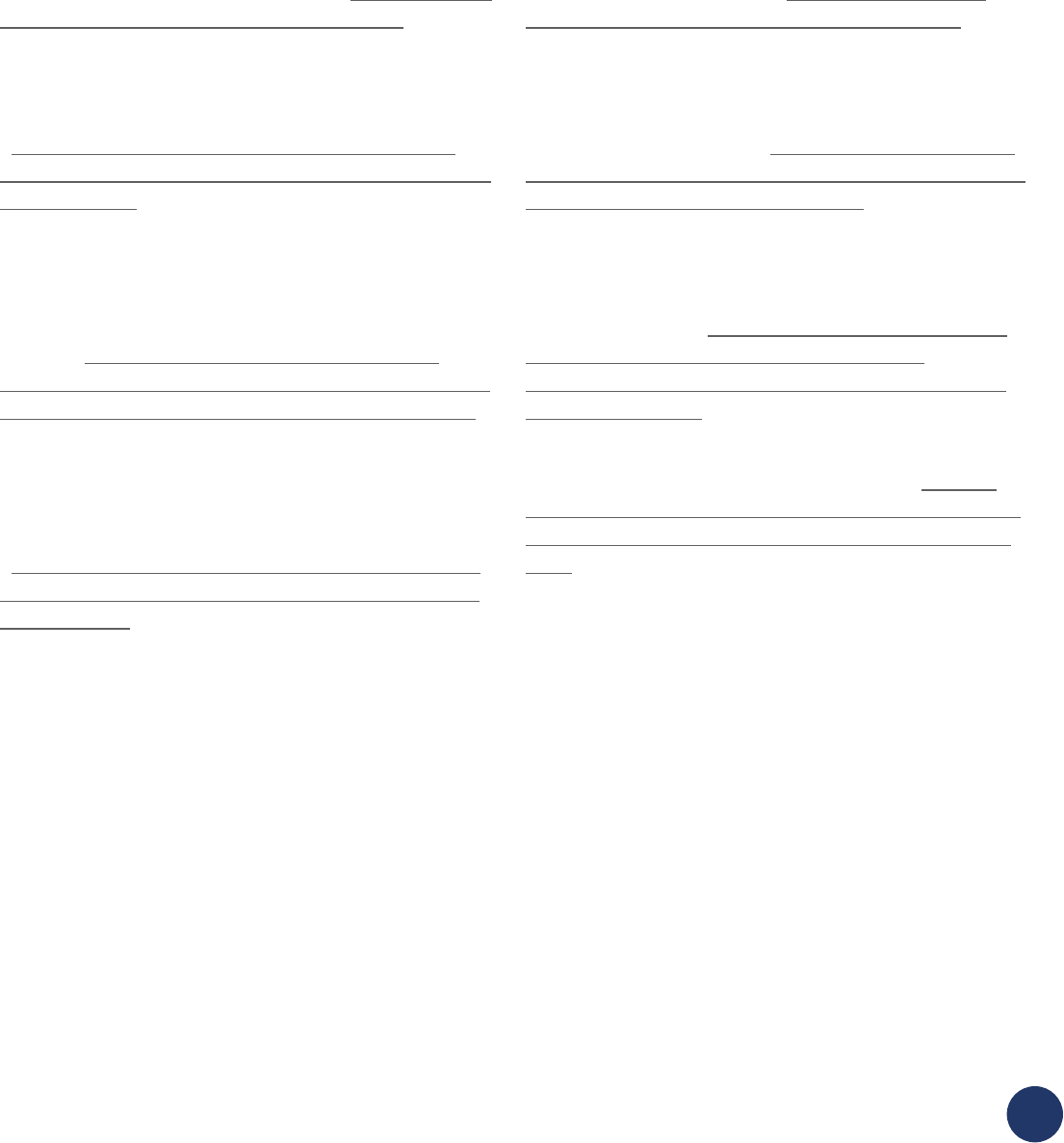
Additional Sources
“Compounding Debt: Race, Affordability, and
NYC’s Tax Lien Sale,” from the Coalition for Af-
fordable Homes in New York City <https://cnycn.
org/report-compounding-debt-tax-lien/>
“The Tax Divide,” a Chicago Tribune series on
how assessments in Cook County tend to favor
the wealthy at the expense of the less affluent:
<https://www.chicagotribune.com/investiga-
tions/ct-tax-divide-investigation-20180425-sto-
rygallery.html>
“Reassessing the Property Tax” by Christopher
Berry, professor at The University of Chicago
Harris School of Public Policy. This study ques-
tions whether mass-appraisal systems can ever
be fair: <https://cpb-us-w2.wpmucdn.com/
voices.uchicago.edu /dist/6/2330/les/2019/04/
Berry-Reassessing-the-Property-Tax-3121.pdf>
“Racial Disparities and Cook County Tax Sale
Evictions,” a study from Housing Action Il-
linois that shows tax delinquency evictions
disproportionately affected Black communities:
<https://housingactionil.org/downloads/Policy/
Racial-Disparities-and-Cook-County-Tax-Sale-
Evictions.pdf>
“Unconscionable: Tax Delinquency Sales as a
Form of Dignity Taking,” by University of Virginia
Professor Andrew Kahrl: <https://scholarship.
kentlaw.iit.edu /cklawreview/vol92/iss3/11/>
“The Assessment Gap: Racial Inequalities in
Property Taxation,” by Carlos Avenancio-León,
Indiana University, and Troup Howard, University
of California, Berkeley: < https://equitablegrowth.
org/working-papers/the-assessment-gap-racial-
inequalities-in-property-taxation/>
“Estimating Property Tax Shifting Due to Regres-
sive Assessments,” by Professor Christopher
Berry of the University of Chicago Harris School
of Public Policy. < https://cpb-us-w2.wpmucdn.
com/voices.uchicago.edu/dist/6/2330/
les/2020/02/Tax-Shifting-Due-to-Regressive-
Assessments.pdf >
“How Lower-Income Americans Get Cheated
on Property Taxes,” New York Times. < https://
www.nytimes.com/2021/04/03/opinion/sunday/
property-taxes-housing-assessment-inequality.
html >
30

How the Illinois Property Tax System Works
References
Berry, C. (2021). Reassessing the Property Tax.
Berry, C., Atuahene, B., Black, D., Fowler, A., Fouir-
naies, A., Gottleib, J., . . . Wang, X. (2021,
3). Reassessing the Property Tax. Chicago.
Retrieved from www.census.gov/data/
datasets/2016/econ/local/public-use-
datasets.html
Brown, P., & Hepworth, M. (2002). A Study of
European Land Tax Systems Second Year
Report Lincoln Institute of Land Policy
Working Paper.
Carlos, A.-L., Troup, H., Avenancio-León, C.,
Howard, T., Aneja, A., Cicala, S., . . .
Zucman, G. (2000). Working paper series
The Assessment Gap: Racial Inequalities
in Property Taxation https://equitable-
growth.org/working-papers/the-assess-
ment-gap-racial-inequalities-in-property-
taxation/ The Assessment Gap: Racial
Inequalities in Property Taxation. Retrieved
from https://equitablegrowth.org/
working-papers/the-assessment-gap-
Coalition for Affordable Homes. (n.d.). Com-
pounding Debt Race, Affordability, and
NYC’s Tax Lien Sale.
Housing Action Illinois. (2010). RACIAL DIS-
PARITIES AND COOK COUNTY TAX SALE
EVICTIONS.
Retrieved from https://www.nytimes.
com/2021/04/03/opinion/sunday/proper-
ty-taxes-housing-assessment-inequality.
html
Illinois Department of Revenue. (2020). The Il-
linois Property Tax System. Retrieved from
https://www2.illinois.gov/rev/research/
publications/Documents/localgovern-
ment/ptax-1004.pdf
Illinois Department of Revenue. (n.d.). PTAX 1-M,
Introduction to Mapping for Assessors.
Springeld, IL.
Retrieved from https://www.illinoistax.org/index.
php/illinois-school-funding-property-tax-
reliance-down-but-new-demands-for-
state-funds-loom-mike-klemensolten/
Illinois State Statutes. (n.d.). (35 ILCS 200/)
Property Tax Code. Illinois Compiled
Statutes (ILCS). Retrieved from https://
www.ilga.gov/legislation/ilcs/ilcs5.
asp?ActID=596&ChapterID=8
Institute of Land Policy, L., & Center for Fiscal
Excellence, M. (2015). 50-State Property
Tax Comparison Study.
Kahrl, A. (n.d.). Chicago-Kent Law Review Chica-
go-Kent Law Review Volume 92 Issue 3
Dignity Takings and Dignity Restoration
Unconscionable: Tax Delinquency Sales
as a Form of Dignity Unconscionable: Tax
Delinquency Sales as a Form of Dignity
Taking Taking. Retrieved from https://
scholarship.kentlaw.iit.edu/cklawre-
viewhttps://scholarship.kentlaw.iit.edu/
cklawreview/vol92/iss3/11
Lincoln Institute of Land Policy. (2022). State-by-
State Property Tax at a Glance.
NEA Research. (2021). Rankings of the States
2020 and Estimates of School Statistics
2021 NEA Research.

Schmidt, M. (2021). Cook County Scavenger Sale
Evaluation. Retrieved from https://harris.
uchicago.edu/les/scavenger_sale.pdf
Retrieved from https://taxfoundation.org/publica-
tions/sources-of-government-revenue-in-
the-oecd/
The Pappas Studies. (2020). Scavenger Study.
The Pew Charitable Trusts. (2021). How Local
Governments Raise Their Tax Dollars.
Retrieved from https://www.pewtrusts.
org/en/research-and-analysis/data-visu-
alizations/2021/how-local-governments-
raise-their-tax-dollars
The Pew Charitable Trusts. (2021, July 27).
How Local Governments Raise Their Tax
Dollars. Retrieved from The Pew Chari-
table Trusts: https://www.pewtrusts.org/
en/research-and-analysis/data-visualiza-
tions/2021/how-local-governments-raise-
their-tax-dollars
The Pew Charitable Trusts. (2021, July 27).
How Local Governments Raise Their Tax
Dollars.
Retrieved from https://apps.chicagotribune.com/
news/watchdog/cook-county-property-
tax-divide/appeals.html
Retrieved from https://apps.chicagotribune.com/
news/watchdog/cook-county-property-
tax-divide/assessments.html
William, C., & Freidman, A. (n.d.). Estimating
Property Tax Shifting.
32
How the Illinois Property Tax System Works
Glossary
Accrual Basis – A way of measuring pension and
other benet funding levels that counts employee
contributions when they are due, and benet
payments and refunds when they are made.
Unlike actuarial basis (below), accrual basis does
not weigh future benet payments against invest-
ments and expected returns.
Actuarial Basis – A complex determination
of whether investments held by a pension or
other benet plans are adequate to cover future
expenses. The determination weighs expected
future benet payments against the level of
investments and how much they are expected
to earn over time, resulting in a determination of
unfunded liability.
Adjusted Equalized Assessed Value – The nal
assessed value of a property determined by
multiplying the assessment by the equalization
rate and then subtracting exemptions.
Annual Tax Sale – The annual auction held by
county treasurers to sell liens on property tax-
delinquent properties.
Assessed Value – The estimated value, based on
market conditions, of a property used to deter-
mine the share of the total property tax that each
property owner must pay.
Assessment Level – The percentage of fair cash
value (what a property would sell for in an arms-
length transaction) at which assessments are set
within a jurisdiction.
Assessment/Sales Ratio Study – A study that
compares assessed values to actual property
sales transactions to determine whether assess-
ments hit their proper assessment level.
Assessor – The county or township ofcial who
determines assessed values of all properties
within a jurisdiction for property tax purposes. In
Illinois, assessors work at either the township or
county level.
Board of Review – A three-member panel of
elected or appointed ofcials who decide property
tax appeals.
Classification – The designation of a property
by type, such as vacant, residential, multi-family,
agricultural, commercial or industrial. The clas-
sication determines the percentage of fair cash
value at which a property is assessed for taxing
purposes.
Clerk – The county ofcial who assigns property
index numbers and calculates property tax rates
applied to the value of each property within the
county.
Cook County Land Bank Authority – A quasi-
governmental agency that works to restore
tax-delinquent and otherwise distressed proper-
ties to productive use. Most of its property has
historically been obtained at the Scavenger Sale.
Delinquent Tax – The amount of property tax not
paid by the due date.

Effective Tax Rate – The percentage of a prop-
erty’s fair market value paid in property taxes
each year.
Equalization Rate – The amount by which Il-
linois assessments are multiplied to ensure the
total value of all properties within each county
or township equals 33
1
/
3
% of market value. This
term is commonly referred to as the multiplier.
Equalized Assessed Value – The assessed value
of a property determined by multiplying the as-
sessment by the equalization rate.
Exemption – A reduction in assessed value based
on the type of property, income and other factors
granted to a property owner.
Extension – The process, conducted by the
county clerk, of determining tax rates for each
owners of certain types of property.
First Installment – The rst of two property tax
bills sent out each year. This bill is 55% of the
previous year’s property tax on the property being
billed.
Forfeited – The status of a property when the
taxes are delinquent and a tax buyer did not
purchase the lien on the delinquent taxes at the
annual tax sale. In those cases, the county holds
the lien to the property.
Home Rule Government – A municipal govern-
ment granted additional authority, including
added taxation powers, by the state of Illinois.
Municipalities that have more than 25,000 resi-
dents is automatically granted home rule powers,
unless voters overturn those powers in a referen-
dum. Voters can also approve home rule powers
for municipalities with less than 25,000 residents
via referendum.
Illinois Department of Revenue – The state
agency with myriad nancial duties, including
conducting sales/ratio studies and setting the
equalization factor.
Illinois Property Tax Extension Limitation Law
– An Illinois statute that limits annual property
tax increases by non-home rule governments to
5% or the increase in the consumer price index,
whichever is less.
Leasehold Tax – When for-profit companies
lease space in a tax-exempt building owned
by a non-profit or government entity, the for-
profit company is liable for property taxes on
the portion of property it uses. This is called
a leasehold tax.
Lien – An unpaid debt legally assigned to a prop-
erty. The holder of the lien is entitled to recoup
their debt upon sale of the property.
Levy – The total amount of taxes sought by a
local government unit in a given year.
Local Government – An elected or appointed
board designated to deliver services within a
given area of the state. These include counties,
forest preserve districts, municipalities, school
districts, park districts and library districts,
among other entities.
34
How the Illinois Property Tax System Works
Market Value – The amount of money a property
would sell for in an arms-length transaction. In
Illinois, this is called the fair cash value.
Median Property Tax Bill – The property tax bill
in a taxing jurisdiction that falls at the center of
all billed amounts in a jurisdiction, meaning there
are equal numbers of higher and lower tax bills in
that jurisdiction.
Municipality – A city, village or town.
No-cash Bid – A bid at a Scavenger Sale by the
county on behalf of a local government or by
the Cook County Land Bank Authority. Although
the county and Land Bank do not have to make
payment on the bid, it is considered a bid for the
entire amount of taxes, interest and fees owed on
the property.
Parcel – An area of land, with or without im-
provements, assigned a property index number
for property transaction recording and taxing
purposes.
Pappas Studies – A series of studies on the Cook
County property tax system created and pub-
lished by the Cook County Treasurer.
Property Index Number – The 14-digit number
assigned by the county Clerk to each parcel for
recording and taxation purposes. This is typically
referred to as the PIN.
Property Tax Appeals Board – The statewide
agency that hears property tax assessment
appeals led by property owners contesting the
assessment level assigned to their properties if
they were dissatised with the results of earlier
appeals at the local level.
Rate – The amount by which adjusted equalized
assessed values are multiplied to determine the
tax owed.
Recorder of Deeds – The agency that records all
property transactions. In Cook County, this ofce
has been absorbed by the county Clerk.
Redemption – When a property owner pays
off the full tax liability for a tax year previously
offered at a tax sale.
Scavenger Sale – A Cook County auction of tax
liens on properties with at least three delinquent
tax years. The auction may be conducted every
two years, at the direction of the county Board of
Commissioners.
Sale in Error – An error that vacates a property
tax sale, leading to a tax buyer getting all of their
money back, often with interest
Second Installment – The second of two property
tax bills sent out each year. This bill is based
on the current levies and assessed values. It
amounts to the total tax bill for the year, minus
the 55% of the prior year’s tax owed.
Subsequent Tax – Taxes owed after a tax buyer
purchases a lien on previous unpaid taxes. If the
taxpayer doesn’t pay subsequent taxes, or sub
taxes, by the due date, the tax buyer may pay the
sub taxes and charge an immediate 12% interest
rate on that payment.
Tax Buyer – An individual or company that pays
delinquent taxes in exchange for a lien on a tax-
delinquent property.
Taxing Agency – A subunit of local government
(taxing district) that has its own distinct property
tax rate.
Taxing District – The area within which a unit of
local government levies taxes, a term also applied
the to the local government levying those taxes.
Treasurer – The county ofcial who prepares
tax bills, mails them, collects property taxes and
conducts tax lien sales on properties that are
property tax delinquent.
Unfunded Liability – The amount that a pension
or other pension plan falls short of what’s needed
to pay out future promised benets.
How the Illinois Property Tax System Works

38
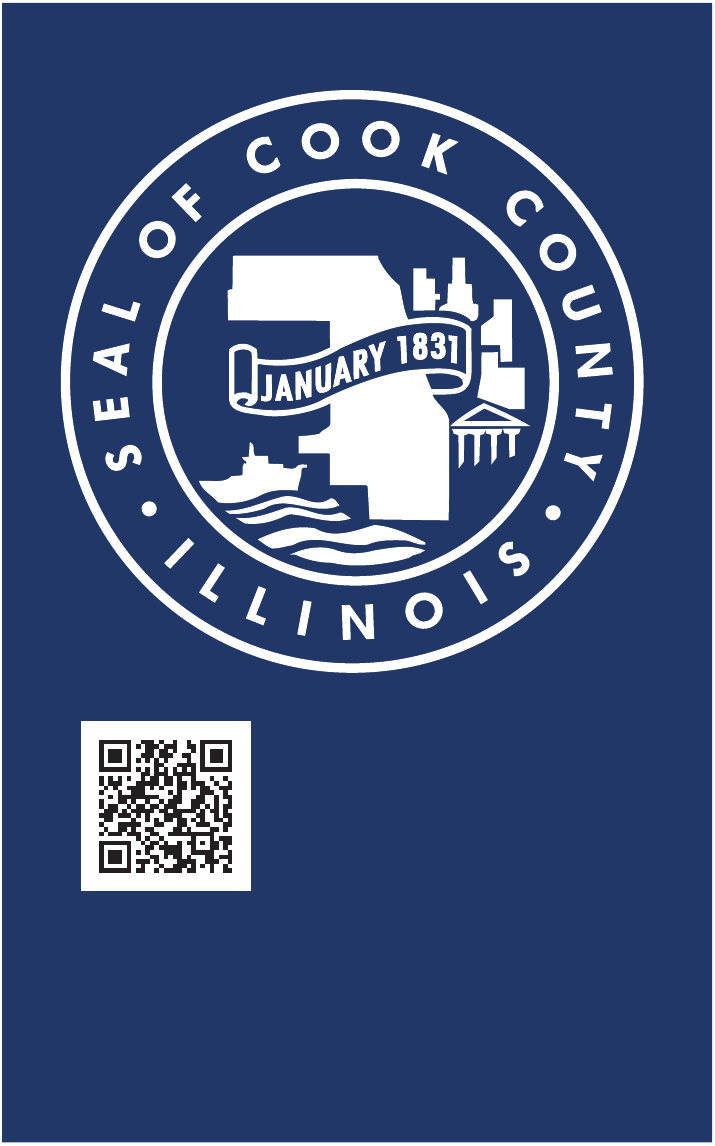
Cook County Treasurer's Oce
118 North Clark Street, Room 112
Chicago, Illinois 60602
(312) 443-5100
